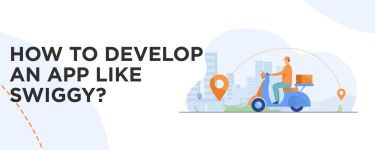35 Best Frameworks for Android Apps Development
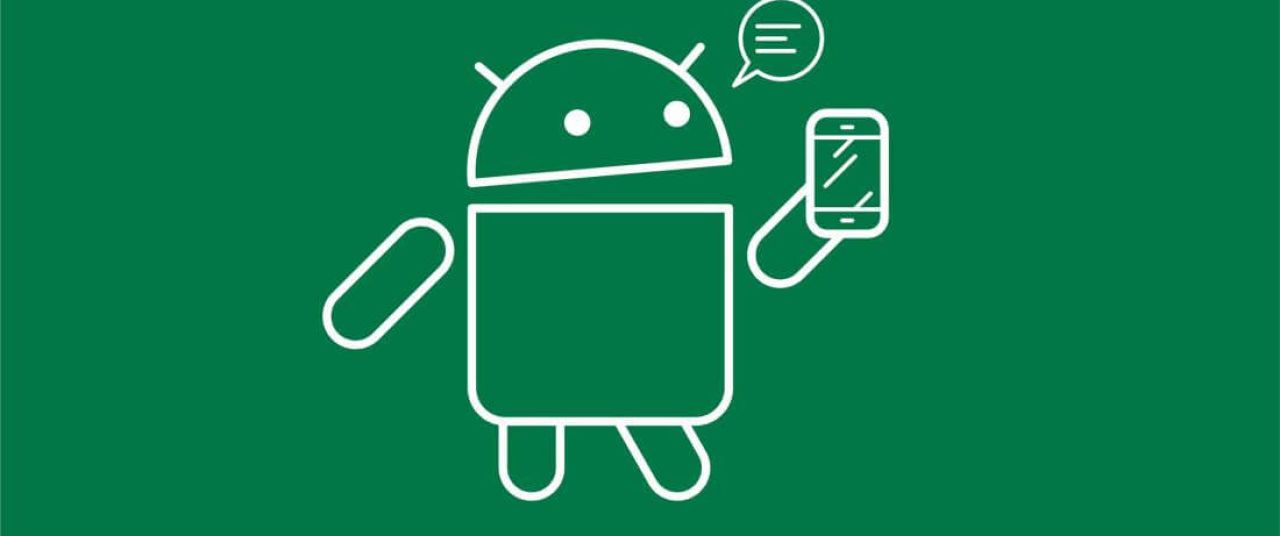
According to Statista research, Android’s market has been growing in the global mobile OS market share in terms of sales to end-users from 2009 to 2017. In the first quarter of 2017, 86.1 percent of all smartphones sold to end users had the Android operating system.
Creating code can be frustrating, and developers have to deal with redundant coding that is visually unattractive. In this article, we talk about the most popular Android frameworks and also what we use at VironIT. All of these frameworks have helped us develop Android apps to be better and faster for our clients.
Top Open Source Frameworks
Most of you have probably heard that quality does not come cheap. Well, this is not at all true for developing Android applications. We have developed most of our apps using one or more of the open-source Android frameworks, and many of our clients’ apps have achieved millions of downloads in App Stores.
Android Data Binding
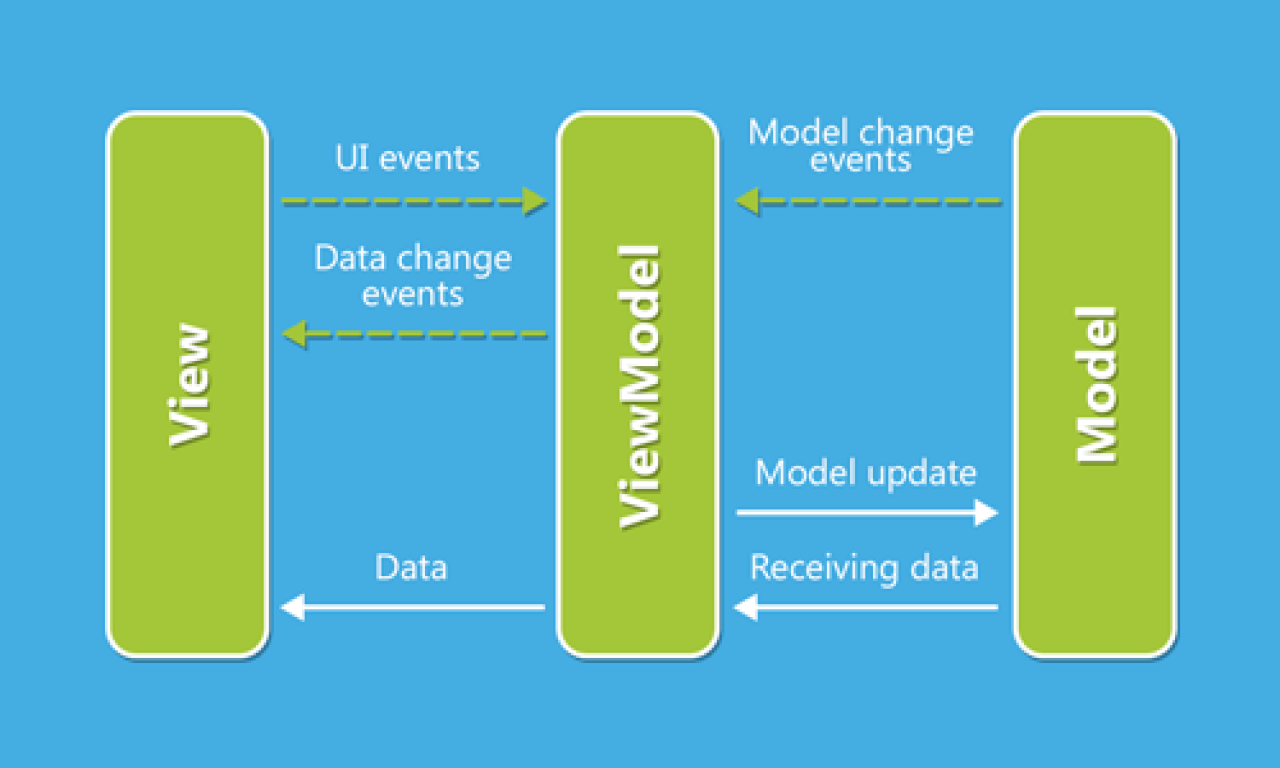
Data binding refers to frameworks or libraries designed to simplify data migration.
Android allows support to write declarative layouts using data binding. This minimizes the necessary code in the application logic to connect to the user interface elements. Data binding offers both flexibility and broad compatibility, so you can use it with all Android platform versions since Android 2.1.To use data binding, Android Plugin for Gradle 1.5.0-alpha1 or higher is required.
What does it offer?
- Makes findViewById totally obsolete
- Encourages the separation of UI logic and business logic
- Makes it easy to synchronize between data sources and UI elements
- Provides a way to bind event listeners using lambda or method reference from XML
- Moves UI logic to XML, which makes the code more readable and simplifies the development process.
- Provides a way to bind custom setter methods or rename setter methods of view’s attributes.
Appcelerator Titanium
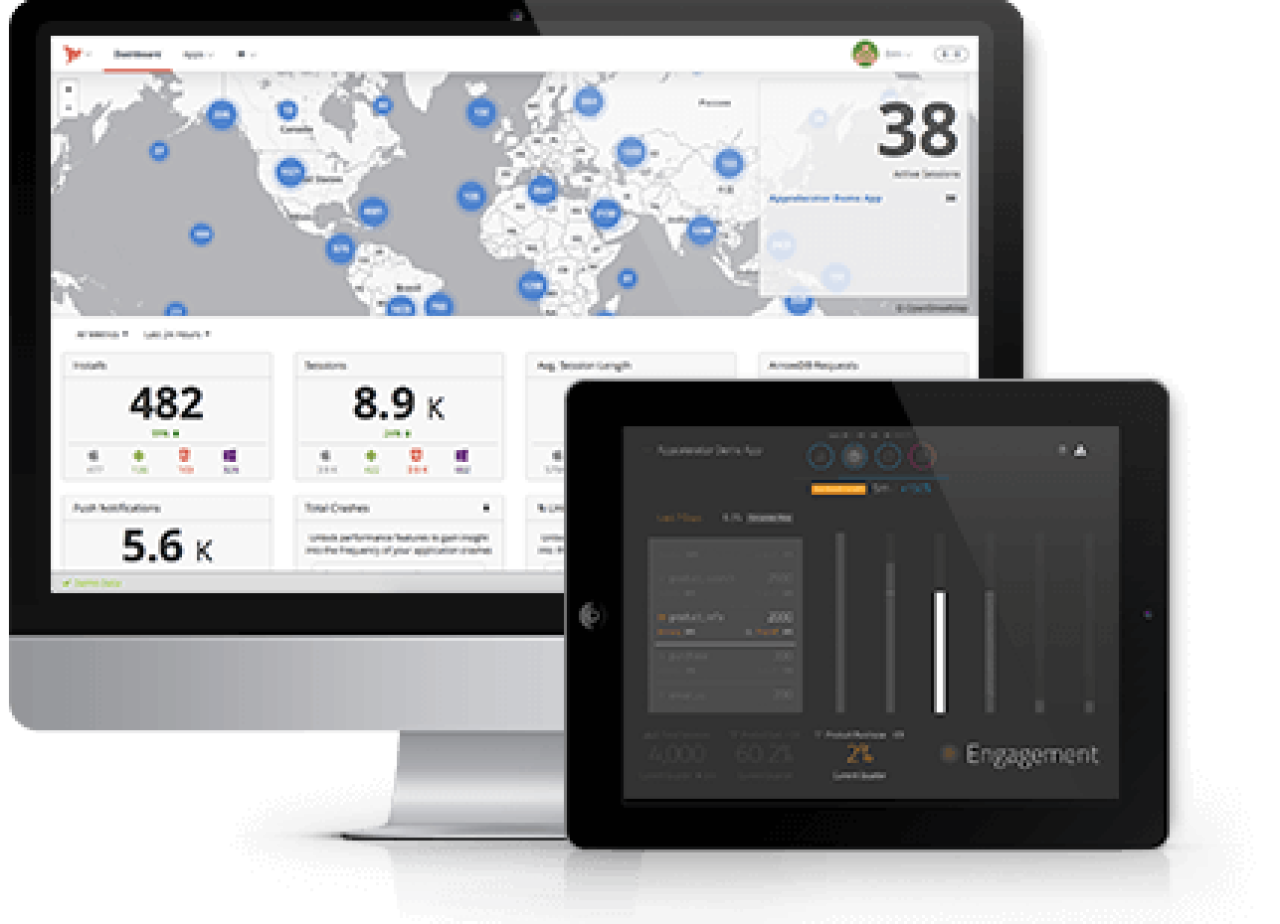
Titanium SDK is an open source extensible development environment for creating native apps across different mobile devices and Oss, including iOS, Android, and BlackBerry, as well as hybrid and HTML5. The core component of Titanium is the Apache-licensed software development kit, Titanium SDK. Appcelerator also makes Alloy, an Apache-licensed, Titanium-based, model–view–controller framework, and Appcelerator Studio, a proprietary integrated development environment. The software is open source, but the full-featured free version is free only if you don’t publish your app, at which point you have to pay at least $39 per month.
What does it offer?
- A cross-platform API to access native UI components and native device functionality
- Transparent access to native functionality covered by Hyperloop and native modules.
- MVC-based framework Alloy.
- Use of hardware-specific features, such as the Android menu button.
- Use of OS-specific controls, such as the Cocoa UI controls on iOS.
- Take part in the platform ecosystem, for example, using platform-appropriate notification mechanisms.
Braintree
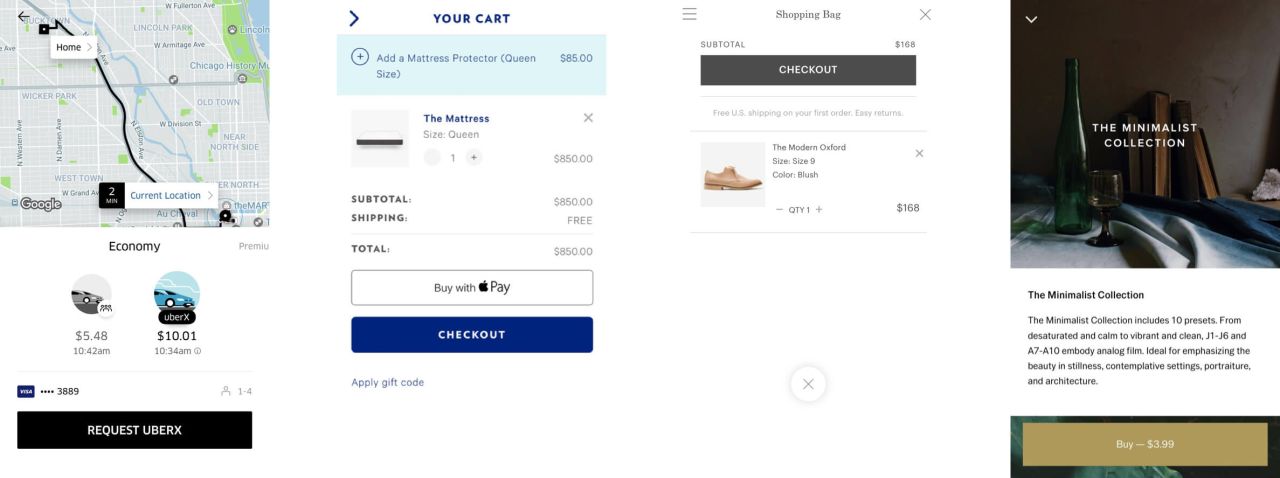
Braintree is a framework that covers all popular payment systems such as PayPal, Apple Pay, Android Pay, Venmo, and Bitcoin. The Braintree SDK is open source framework, but you will have to pay for the transactions made through the app. Braintree can be used in any app that manages transactions.
What does it offer?
- Many different ways to pay: PayPal, Cards, Apple Pay, Venmo, Pay with Google, UnionPay, etc.
- Accepts repeat online payments for software, subscription-based businesses, donations, and more.
- Connects the Braintree integration to your existing e-commerce, ERP, or OMS platform.
- Securely share access to encrypted payment data with other Braintree merchants.
- Talk to a real person to get your questions answered quickly.
ButterKnife
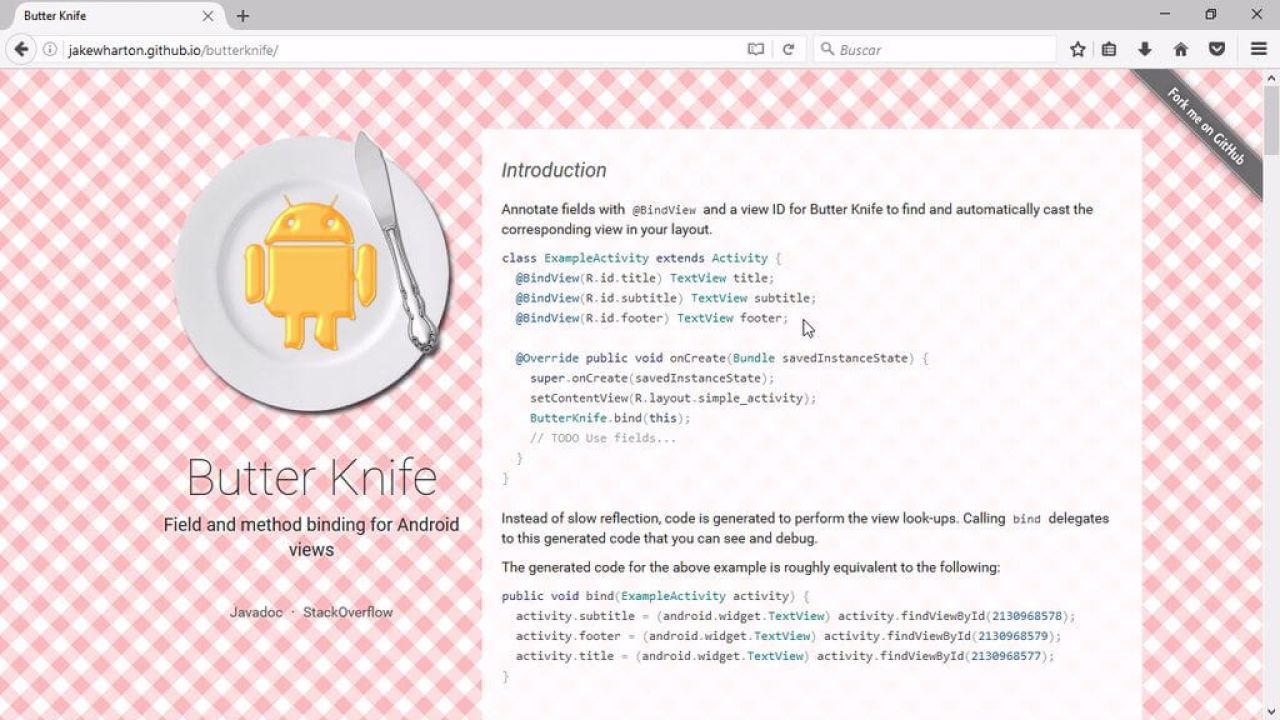
ButterKnife is an open source view “injection” library for Android. ButterKnife is small, simple, and lightweight, and it allows developers to perform injections on arbitrary objects, views, and OnClickListeners so they can focus on writing useful code.
What does it offer?
- Replaces findViewById with @Bind() and set^^^^Listener calls with @onClick(), making code cleaner and more understandable.
- ButterKnife enables focus on logic instead of glue code and decreases development time by reducing redundant coding.
- ButterKnife offers simple field and method binding for Android views.
CodeName One
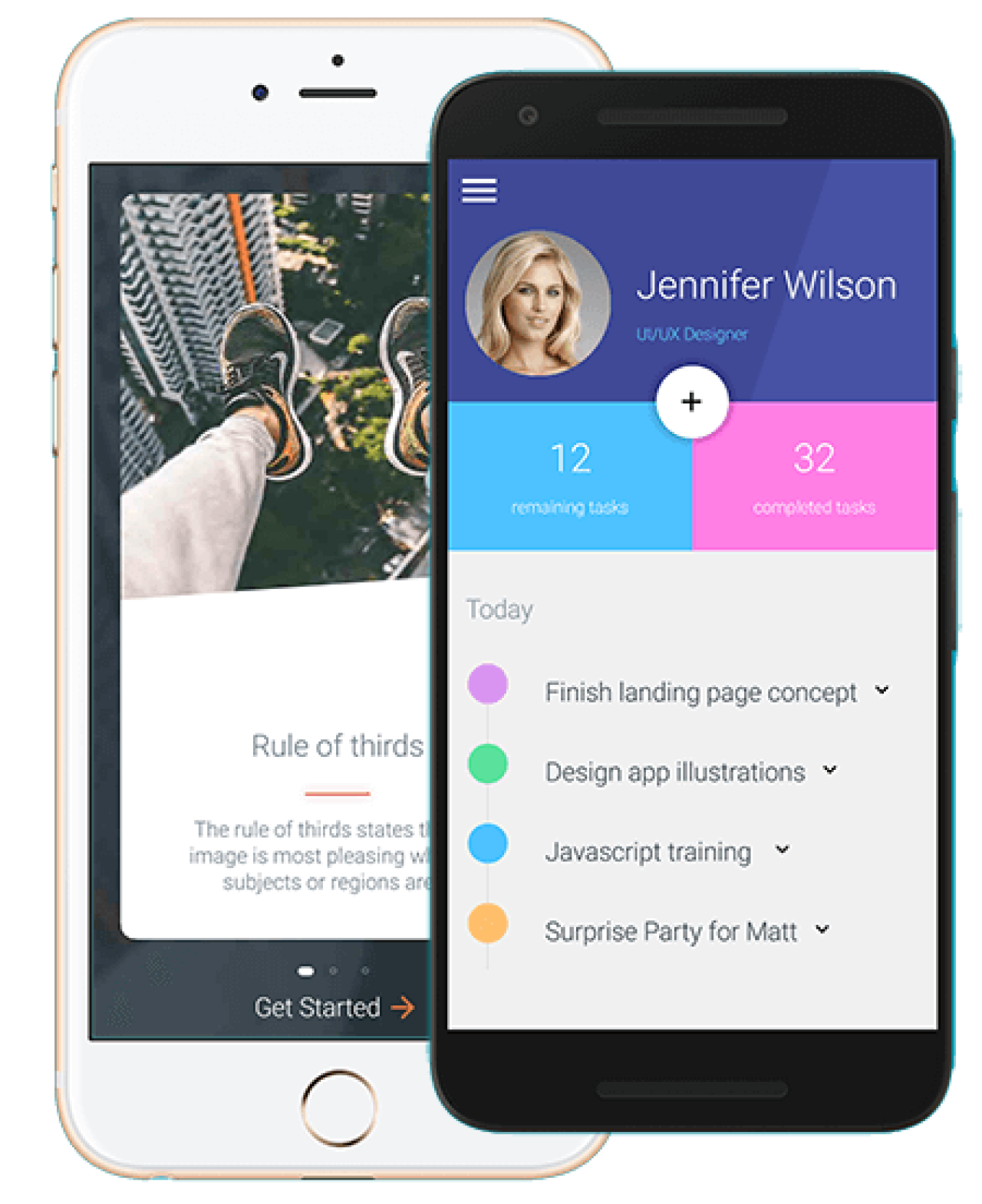
CodeName One is a framework that makes it easier to create multiple versions of their apps. Codename One has even developed a Maker tool that allows non-developers and novices to create their own apps without needing any knowledge of code.
Since it is Java-based, the framework is best for Java developers. For instance, an Android developer seeking entry into the Apple App Store could use Codename One to transform its app into an iOS-ready one.
What does it offer?
- Writes code in Java using Eclipse, NetBeans, or IntelliJ/IDEA.
- Verifies your app with our simulator, devices, and test automation tools.
- Generates native binaries for all device types using the Codename.
- Write Once Run Anywhere, no special hardware, and 100% code reuse.
- Easy to use with 100% portable Drag & Drop GUI builder.
- Full access to native OS using the native language (e.g., Obj-C, C# etc.).
- Uses native widgets and mixes them with our components in the hierarchy.
- Open source and free for commercial use with an enterprise-grade commercial offering.
Corona SDK
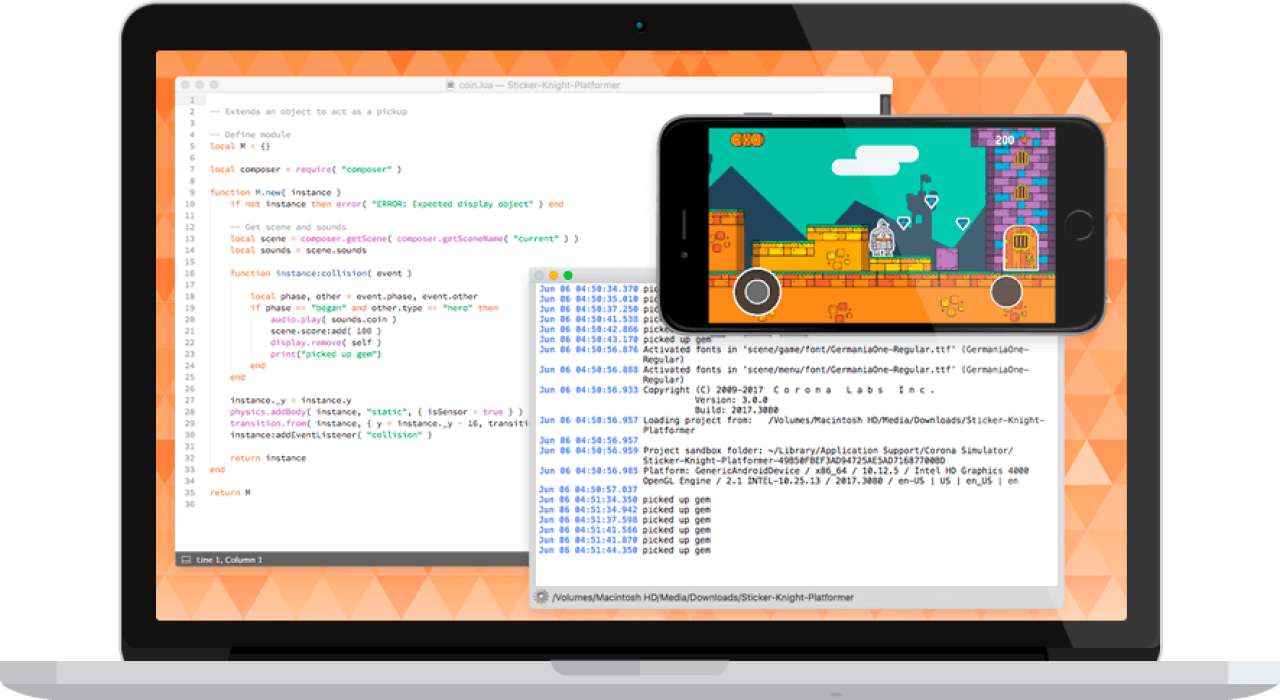
Corona is a cross-platform framework ideal for rapidly creating apps and games for mobile devices and desktop systems. You can create a project once and publish it to multiple types of devices, including Apple iPhone and iPad, Android phones and tablets, Amazon Fire, Mac Desktop, Windows Desktop, and even connected TVs such as Apple TV, Fire TV, and Android TV.
What does it offer?
- Corona is based on Lua, an open source scripting language designed to be lightweight, fast, and powerful. Lua is currently the leading scripting language in games and has been utilized in Warcraft, Angry Birds, and Civilization.
- Select from numerous plugins that extend the Corona core for features like in-app advertising, analytics, media, and much more.
- If it’s not already in the core or supported via a plugin, you can call any native (C/C++/Obj-C/Java) library or API using Corona.
- Develop for mobile, desktop, and connected TV devices with just one code base.
- No hidden fees, charges, or royalties.
- Whether you are an indie developer or a large publisher, you will never pay for core functionality.
Crashlytics
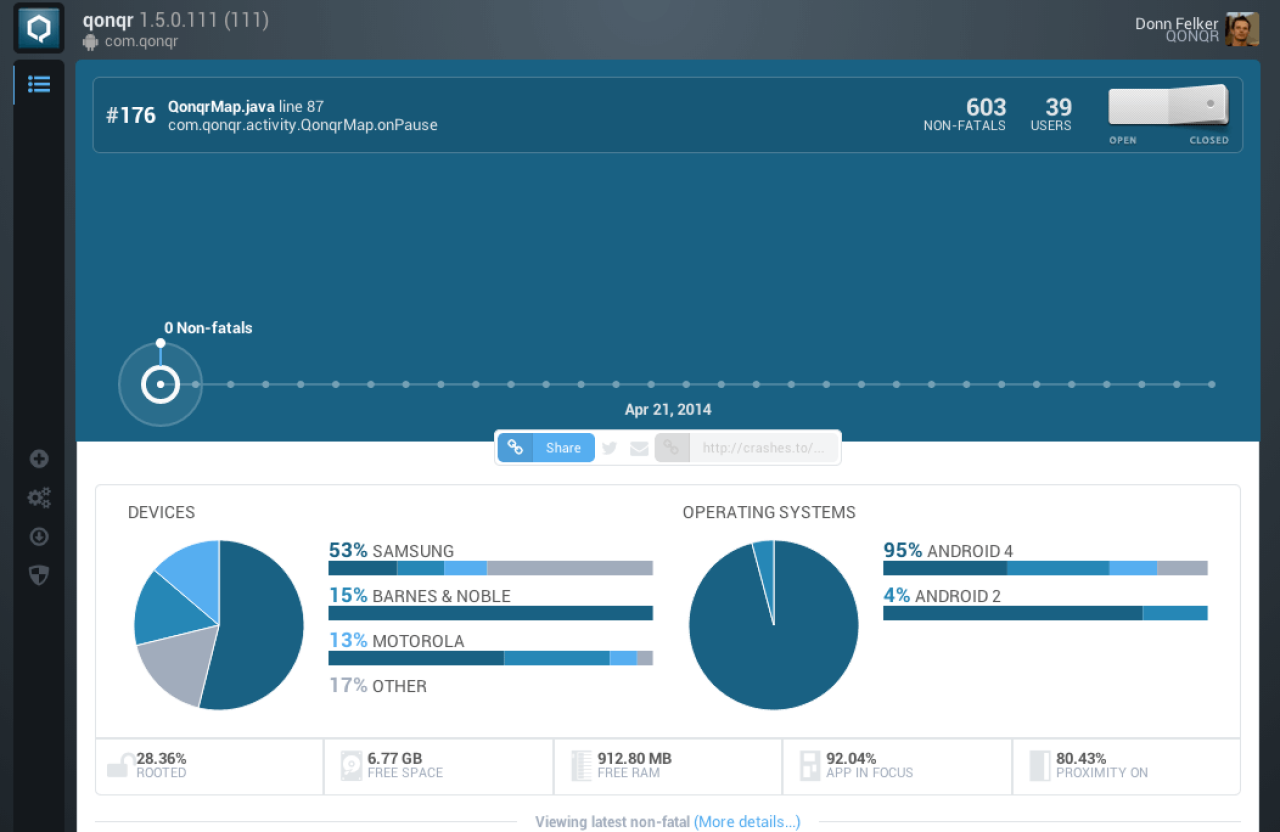
Crashlytics is a framework that delivers interactive, detailed crash reports in real-time. Crashlytics performs a deep analysis of each thread and prioritizes them by importance, so you can spend less time finding and more time fixing issues. It is easy to implement, does not slow your app down, and does not crowd the app with unnecessary data.
p style=”font-weight: 400;”>What does it offer?
- Support for native crashes and errors.
- Instant reports right on your desktop.
- Stack unwinding, the seemingly omniscient ability to determine the historic code execution that directly leads to the crash.
- Capture every crash consistently and without some of the indeterminate behavior of other mechanisms. This also provides data that more closely matches what a developer would see in Xcode.
- The system processes every crash in a record-breaking 18 milliseconds, so you can immediately take action.
ExtJS
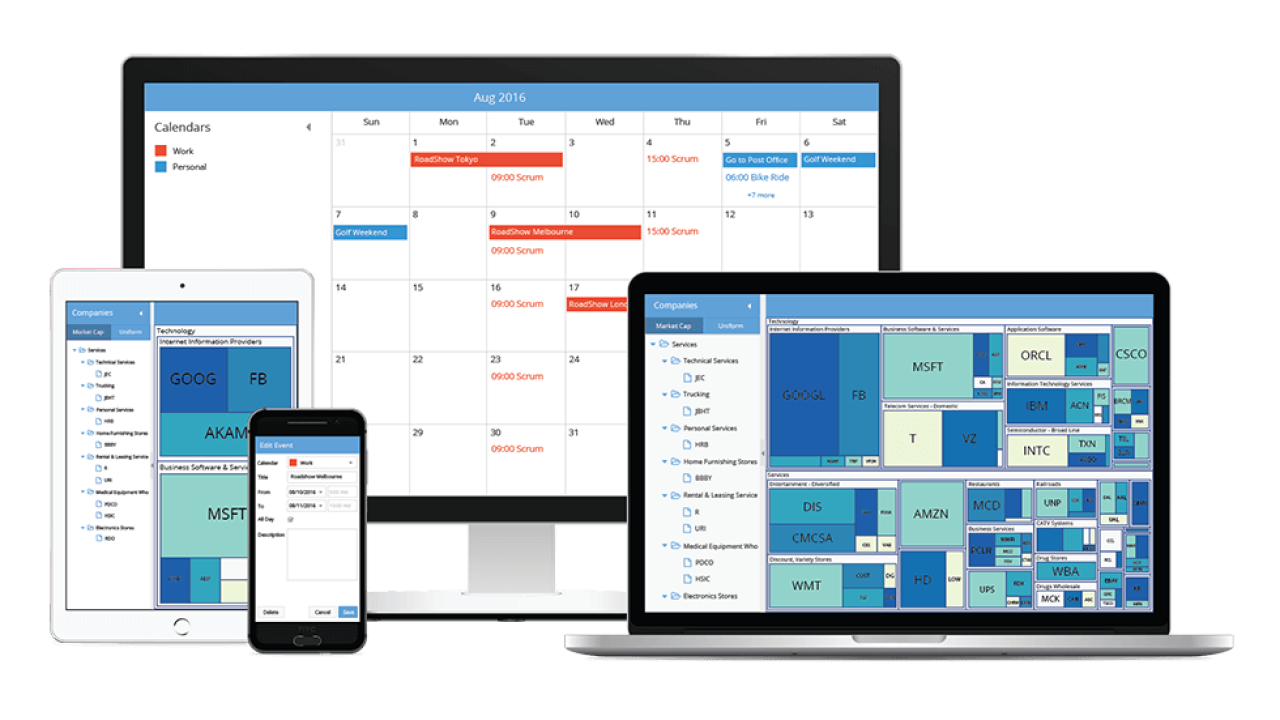
ExtJS is the most extensive library of JavaScript components to date and is remarkable for its development of scalable and high-performance cross-platform applications for iOS, Android, and BlackBerry platforms. Providing amazing flexibility for UI tools, ExtJS is one of the best JavaScript frameworks for mobile development.
What does it offer?
- Pre-integrated and tested UI components
- Rich data analytics
- Sophisticated data visualization
- Back-end agnostic data package
- Layout manager and responsive configs
- Accessibility package (ARIA) for Section 508 compliance
- Customizable built-In themes
Dagger 2
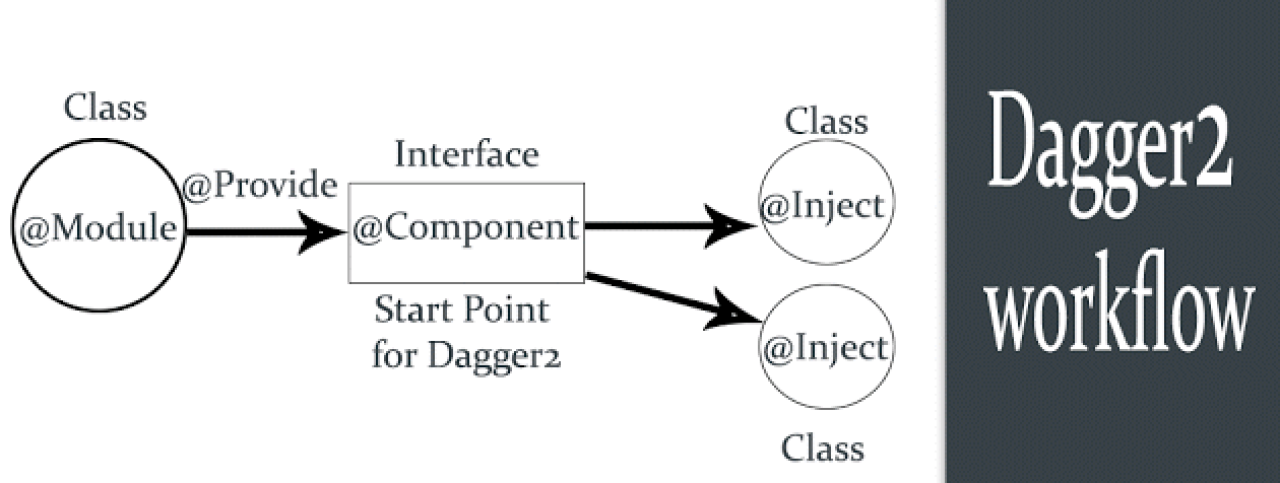
Dagger 2 is a dependency injection framework based on Java Specification Request 330. It uses code generation and is based on annotations, and the generated code is relatively easy to read and debug.
Dagger 2 uses the following annotations:
- @Module and @Provides: define classes and methods that provide dependencies
- @Inject: request dependencies, which can be used on a constructor, a field, or a method
@Component: enables selected modules used to perform dependency injection - Dagger 2 uses generated code to access the fields and not reflection so it is not permitted to use private fields for field injection.
What does it offer?
- Provides a simple way to obtain references to shared instances.
- Easy configuration of complex dependencies. Dagger 2 walks through the dependency graph and generates code that is both easy to understand and trace.
- Easier unit and integration testing. Because the dependency graph is created for us, we can swap out modules that make network responses and take out this behavior.
- Scoped instances. You can leverage Dagger 2 to define instances with shorter lifetimes (i.e., bound to a user session, activity lifecycle, etc.).
Facebook SDK
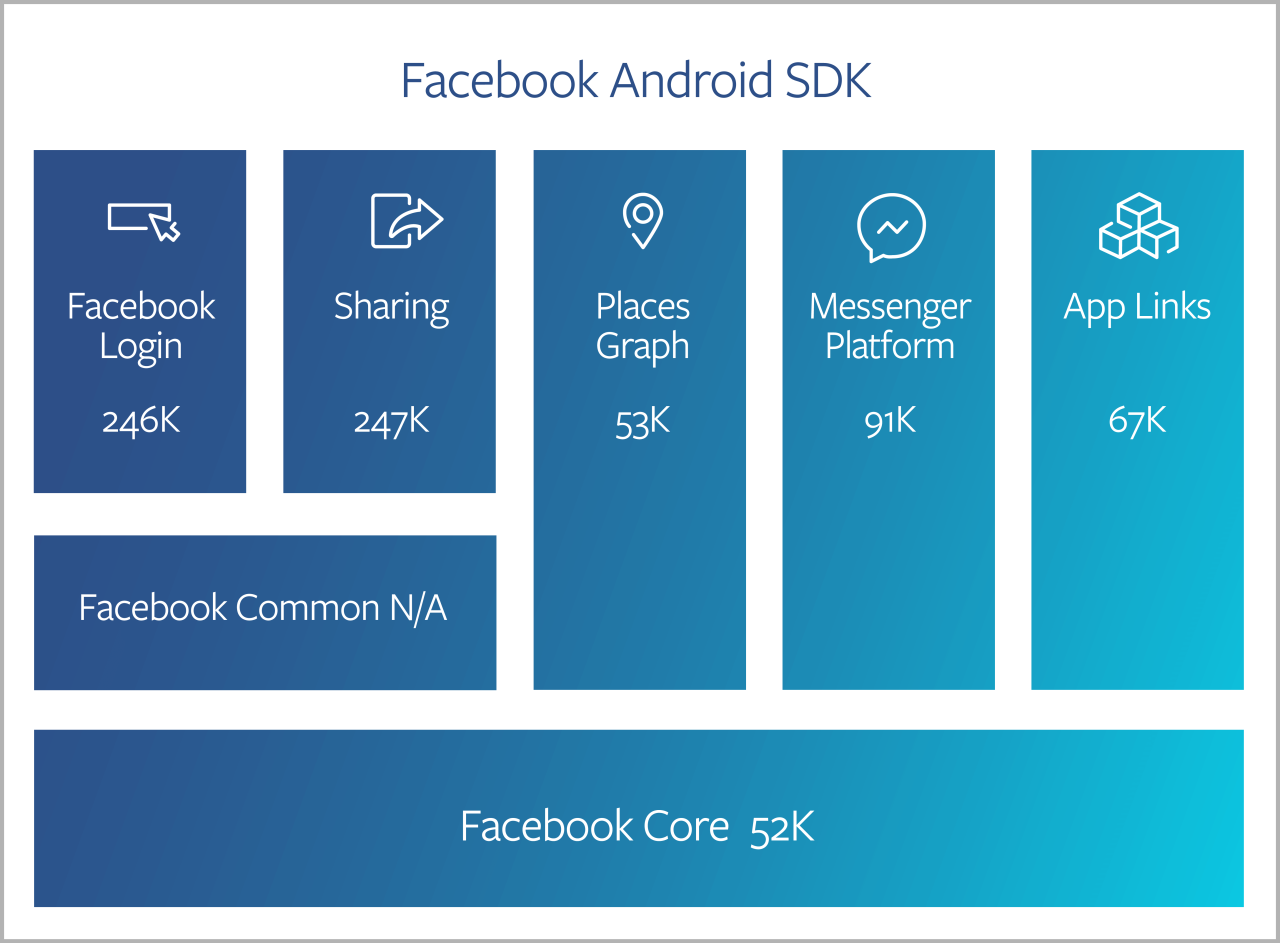
Facebook SDK is an open-source library that allows you to integrate Facebook into your Android app.
The Facebook SDK for Android consists of six components:
- Core
- Login
- Sharing
- Places
- Messenger
- App Links
What does it offer?
- Data, trends, and aggregated, anonymized audience insights about the people interacting with an app.
- Drive installs with Mobile App Install Ads.
- Increase engagement with Mobile App Engagement Ads.
- Find your target audience with Custom Audiences for Mobile Apps.
- A secure and convenient way to log into an app using Facebook.
- App login using a phone number or email address—no password needed.
- Allows people using an app to share, send a message, or similar content. They can also share Custom Stories with Open Graph.
- Get data in and out of Facebook’s social graph, query data, post stories, upload photos, and perform other tasks.
- Understand people’s actions in your app and measure the effectiveness of your Mobile App Ads.
- An open standard to deeply link to content in your app.
Framework 7
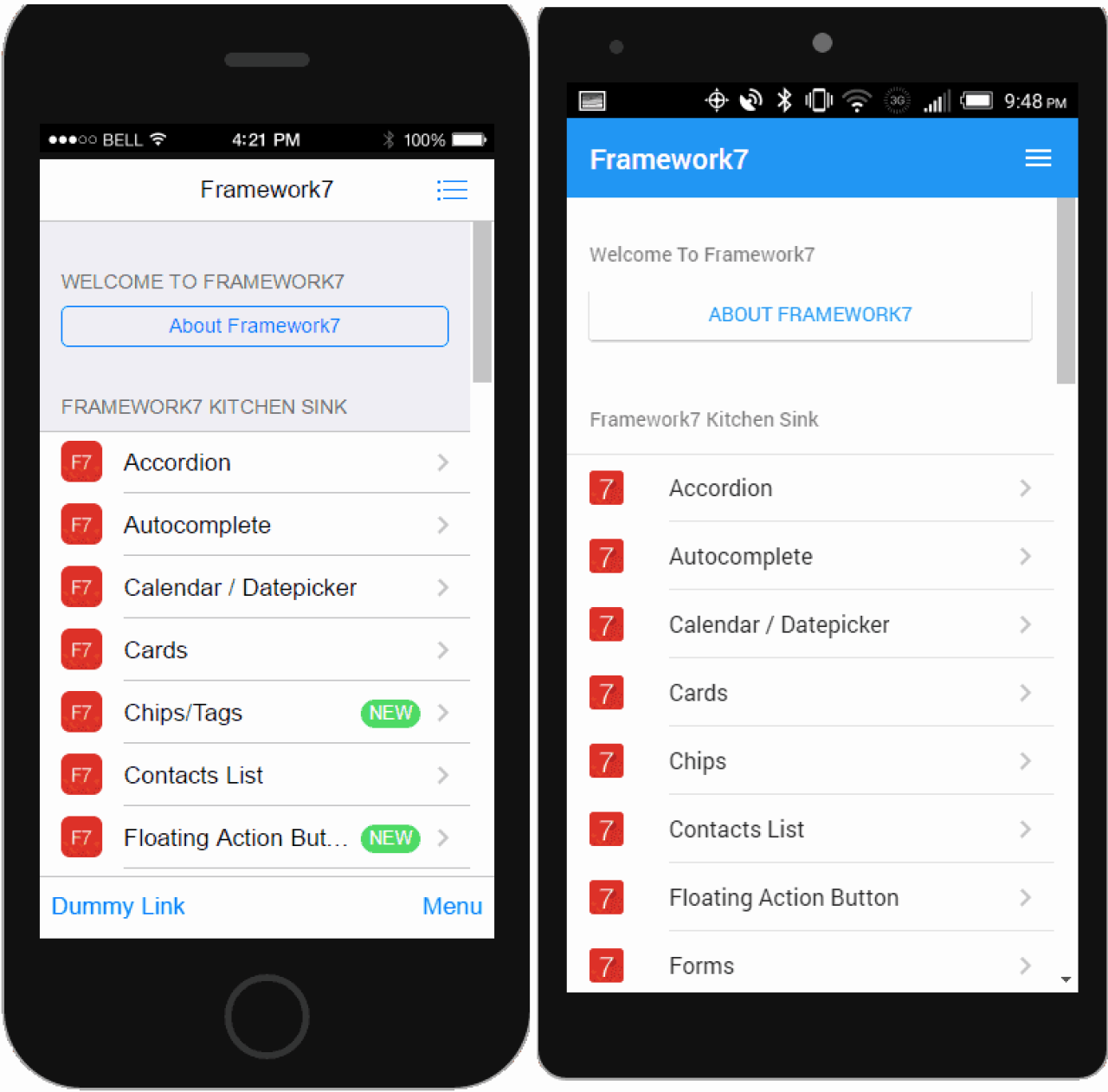
Framework 7 is a free and open source framework based on HTML. Well-equipped with functionality to ease the development of hybrid and web apps featuring a native-like look for iOS and Android platforms. It features prototyping functionality that enables a developer to quickly prepare the prototype of the applications.
What does it offer?
- Native Scrolling allows you to scroll with momentum and resistance bounce without any issues.
- The framework supports an unlimited number of different isolated views. You can control every single view without a line of JavaScript using the “data-view” attribute on links.
- Framework7 does not use and does not depend on any third-party libraries, which is why it is ultra-lightweight, high performance, and flexible.
- It uses clear and easy JavaScript API methods to control every part of the app.
Framework7 uses high-performance hardware, accelerated CSS animations, and transitions. - The framework offers 1:1 page animation with a smooth parallax effect, changing opacity and shadow when loading a new page.
- Framework7 routes your app pages using XHR with its internal methods and HTML configurable caching. That allows to load pages faster and save a lot of time and traffic for your users. It loads a page via Ajax once per specified caching period, and other times it comes from memory.
- It has a custom DOM library that utilizes the most edgy and high-performance methods for DOM manipulation
Fresco
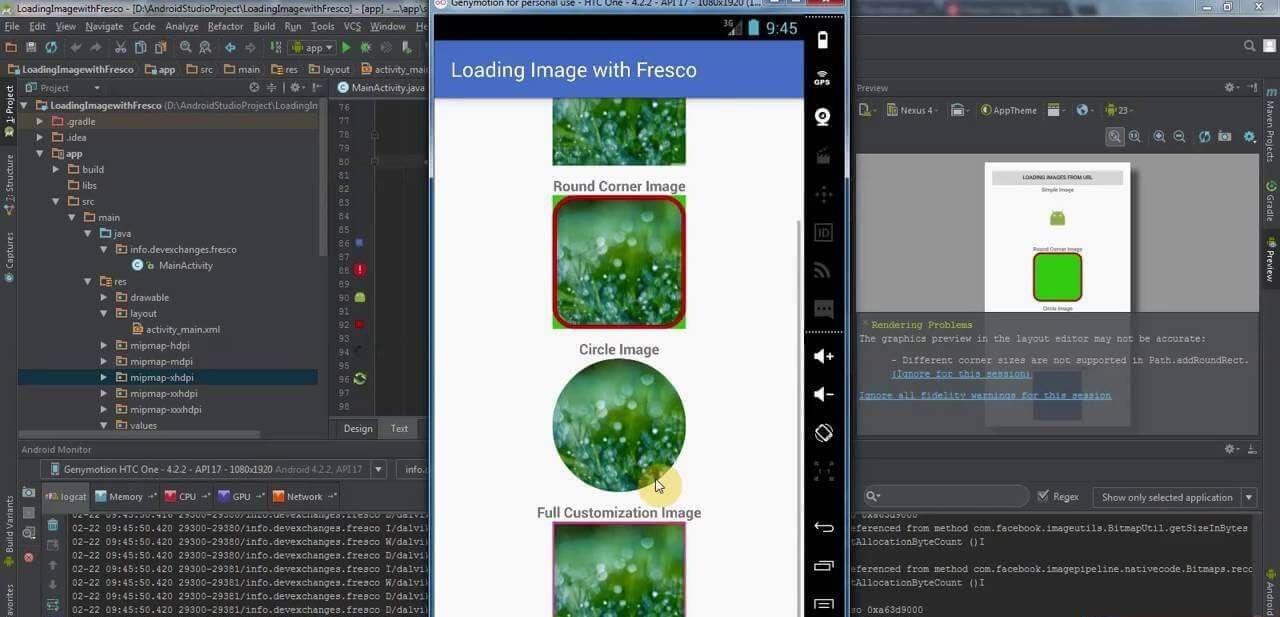
Fresco is a powerful system to display images in Android applications. It takes care of image loading and display. Fresco supports Android 2.3 and later.
What does it offer?
- The image pipeline will load images from the network, local storage, or local resources. To save data and CPU, it has three levels of cache:-; two in memory and another in internal storage.
- Drawee shows a placeholder for you until the image has loaded and then automatically shows the image when it arrives. When the image goes off-screen, it automatically releases its memory.
- On Android 4.x and lower, Fresco puts images in a special region of Android memory. It also makes sure that images are automatically released from memory when they’re no longer shown on screen. This lets your application run faster – and suffer fewer crashes.
- Apps using Fresco can run even on low-end devices without having to constantly struggle to keep their image memory footprint under control.
- Android’s own imaging libraries don’t support streaming. Fresco does. Just specify a URI, and your app will automatically update its display as more data arrives.
- Animated GIFs and WebPs can be challenging for apps. Each frame is a large Bitmap, and each animation is a series of frames. Fresco takes care of loading and disposing of frames and managing their memory.
Ionic
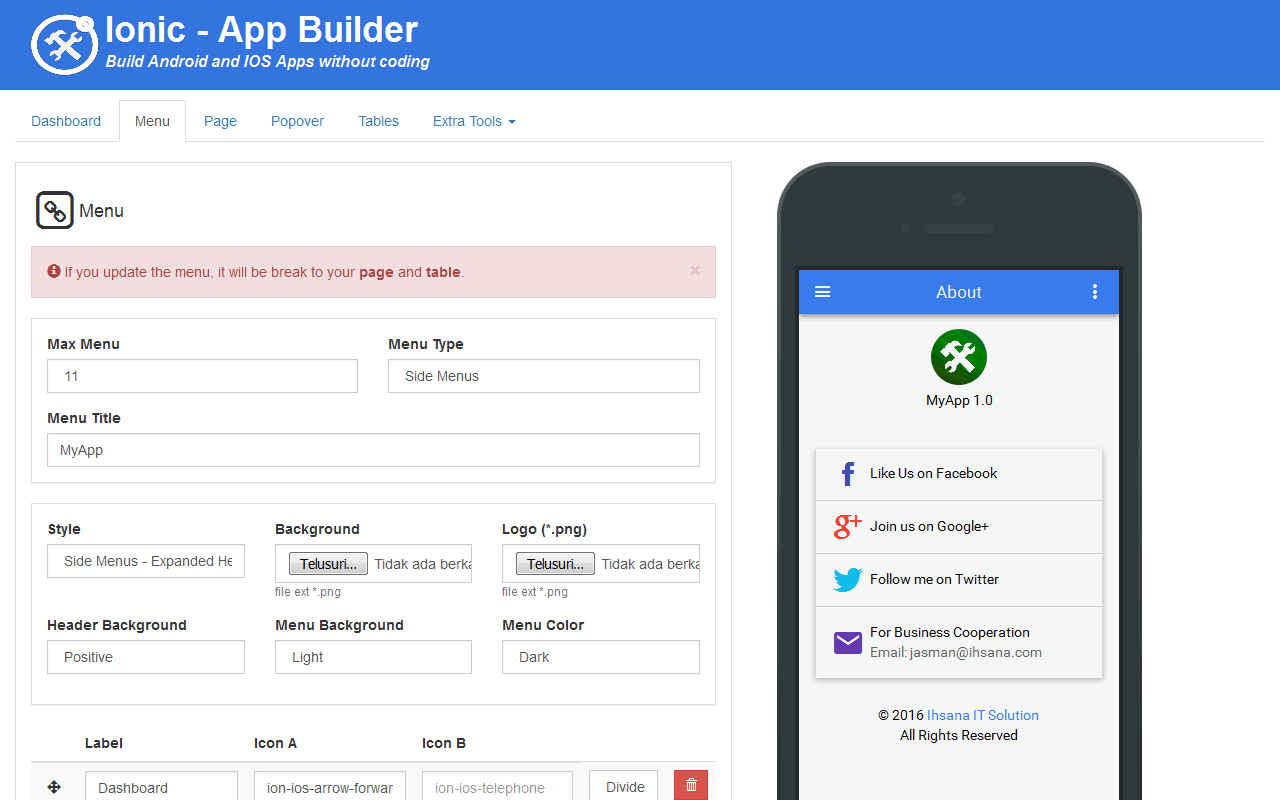
Ionic is an open-source SDK for building cross-platform mobile apps. Built on top of Angular, Ionic also provides a platform for integrating services like push notifications and analytics.
Ionic is not an alternative option to Cordova, but instead a UI library to make a better Cordova project. Ionic can be compared to a framework like Bootstrap or Foundation but this time for Mobile and not Web.
What does it offer?
- A simple CLI to create, build, test, and deploy your Ionic apps onto any platform.
Ionicons icon pack includes hundreds of MIT licensed, and ready out of the box app icons. - Ionic Native unlocks native APIs and features by wrapping Cordova plugins in TypeScript goodness.
- Deep-linking allows you to start your app from a web link to load a specific view right from the bbb.
- Live Reload, because to compile and redeploy your app at every step of development is for chumps.
- AoT Compiling means your app loads lightning fast. Don’t blink on that loading screen, or you’ll miss it.
- One code base running everywhere.
- 100% free and open source project, licensed under MIT.
- Build progressive web and native mobile apps for every major app store, with one codebase.
- Use over 120 native device features like Bluetooth, HealthKit, Finger Print Auth, and more with Cordova/PhoneGap plugins and TypeScript extensions.
- Built with real app examples, component demos, guides, and how-tos to get you up and running with mobile apps faster.
- Supports Android 4.1 and up, iOS 7 and up, Windows 10, and BlackBerry 10.
jQuery Mobile
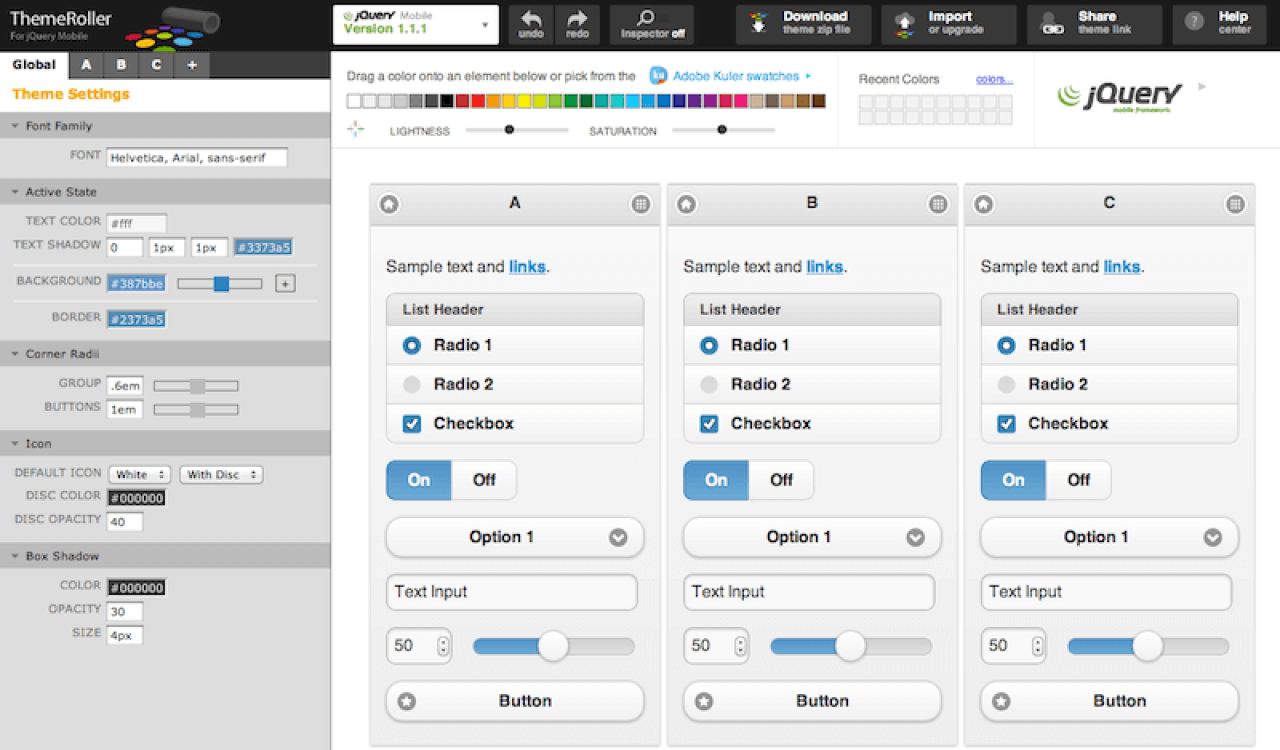
jQuery Mobile is a touch-optimized web framework, specifically, a JavaScript library. The development focuses on creating a framework compatible with a wide variety of smartphones and tablet computers, made necessary by the growing but heterogeneous tablet and smartphone market. The jQuery Mobile framework is compatible with other mobile app frameworks and platforms such as PhoneGap, Worklight and more.
What does it offer?
- Compatible with all major desktop browsers as well as all major mobile platforms.
- Built on top of jQuery core so it has a minimal learning curve for users already familiar with jQuery syntax.
- Theming framework that allows you to create custom themes.
- Limited dependencies and lightweight to optimize speed.
- The same underlying codebase will automatically scale to any screen.
- HTML5-driven configuration for laying out pages with minimal scripting.
- AJAX-powered navigation with animated page transitions that provides an ability to create semantic URLs through pushState.
- UI widgets that are touch-optimized and platform-agnostic.
Kendo UI
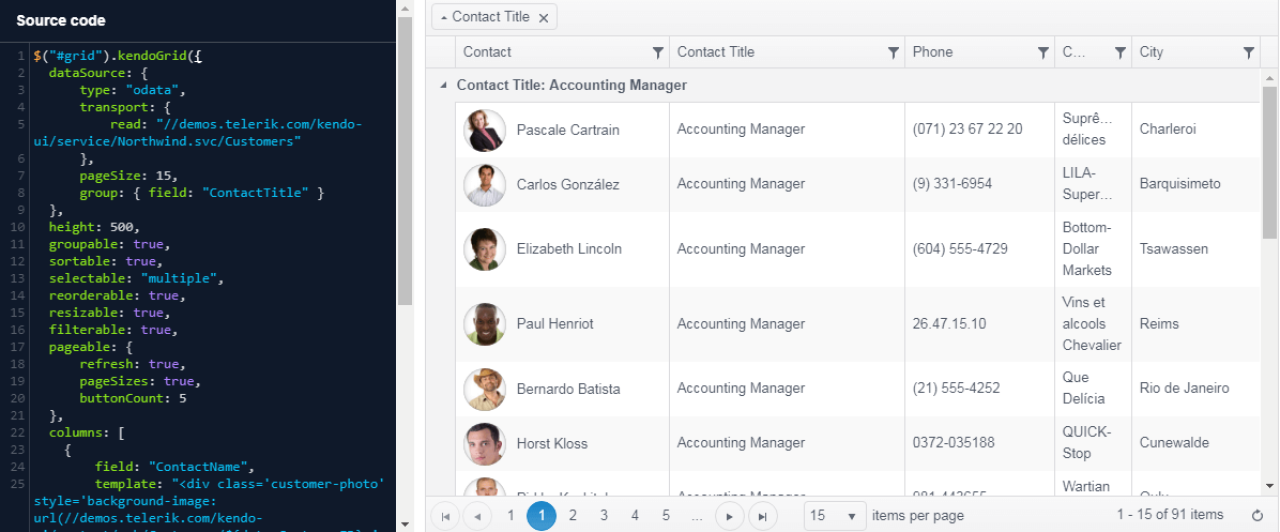
Kendo UI is jQuery-based HTML5/JavaScript framework. It is available in open source and commercial versions. The enterprise-friendly Kendo UI offers a wide selection of UI widgets and plugins. It is best known for its numerous prebuilt themes with Material Design styling, as well as a theme builder for custom themes. Other features include Angular and Bootstrap UI integration, as well as performance optimizations.
What does it offer?
- 70+ UI components.
- Ready-to-use less-based themes to make your app pop without writing any CSS.
- All components integrate seamlessly with grid-layout frameworks, such as Bootstrap and Zurb Foundation.
- Kendo UI uses a common JavaScript language and standards so that it’s easy for any JavaScript developer to get started.
- Online training courses and hands-on exercises help you implement Kendo UI components into your apps.
- Work with data online and offline.
- Kendo UI works seamlessly with all popular frameworks, so you can build apps the way you want to: with AngularJS 1.*, Angular 2+, React, and Vue frameworks.
- Export Excel, PDF, and PNG.
- Leverages latest HTML5/JS features for modern browsers while maintaining compatibility with the old.
- Kendo UI offers flexible support options delivered by the actual product engineers.
Mobile Angular UI
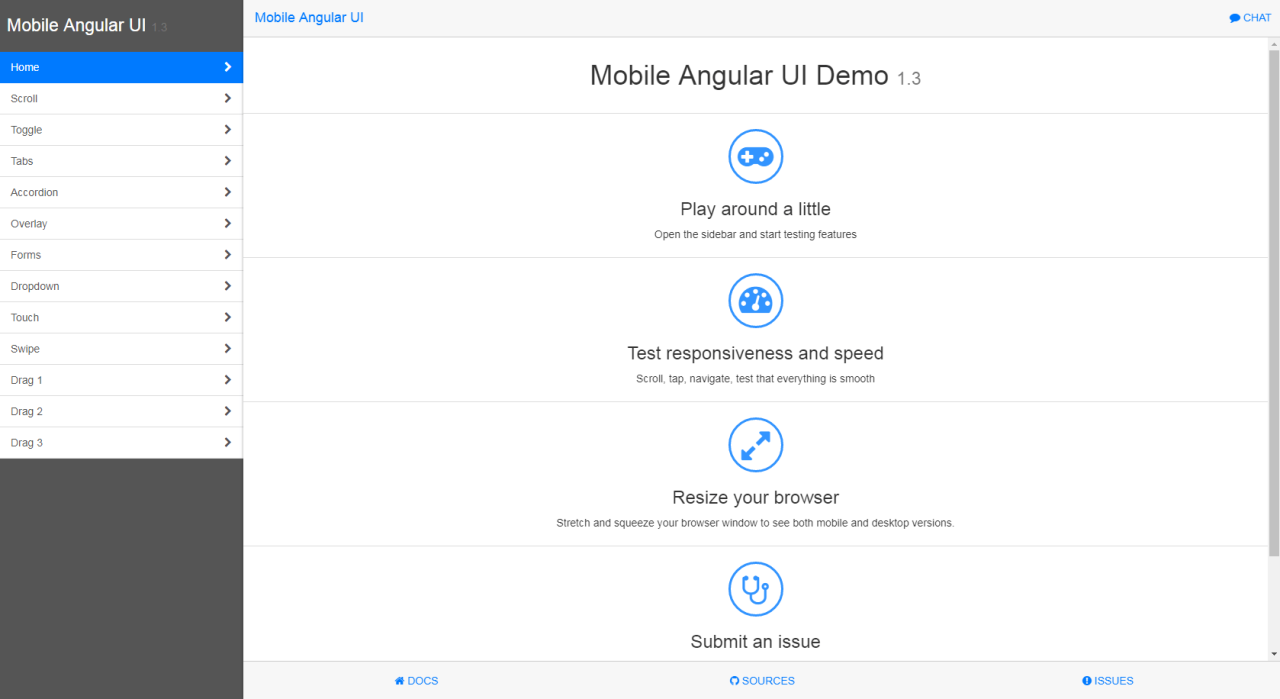
Mobile Angular UI is a mobile UI framework just like jQuery Mobile. If you know Angular JS and Twitter Bootstrap, you already know about it. It is said to retain most of Bootstrap 3’s syntax for easier web-to-mobile portability while adding mobile components missing from Bootstrap, such as switches, overlays, sidebars, scrollable areas, and fixed-positioned navbars. Libraries include fastclick.js and overthrow.js.
What does it offer?
- Essential mobile components: switches, overlays, sidebars, scrollable areas, absolute positioned top and bottom navbars that don’t bounce on a scroll.
- Relies on robust libraries like fastclick.js and overthrow.js to achieve a better mobile experience.
- No jQuery dependencies, no fat bootstrap js, just a few angular.js directives that are super easy to learn to put things together.
- Also, a super-small CSS file is provided to do the opposite. Just include it and you will get a fully responsive and touch-enabled interface that can be used everywhere.
- FontAwesome Icons are included by default in place of Glyphicons.
NativeScript
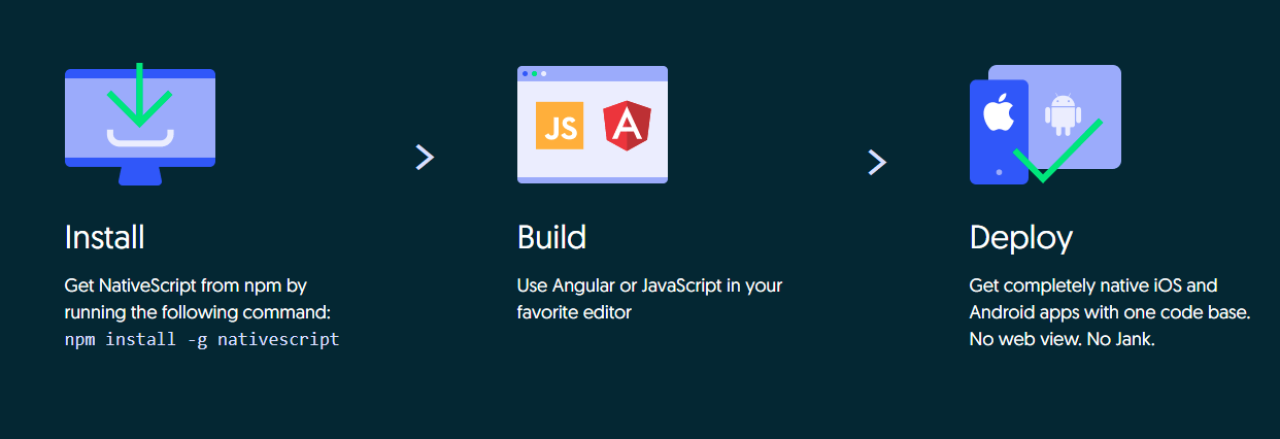
As the name suggests, NativeScript focuses on native UX development. It also offers cross-platform code-sharing support across Android and iOS. The software uses existing native UI libraries, and UI is described with JavaScript, XML, or Angular. It is not as easy to use as Telerik’s more traditional cross-platform Kendo UI framework, however.
What does it offer?
- Builds rich animations, as well as powerful graphs, charts, and lists.
- The robust set of animations are all implemented in pure CSS.
- This app is built with TypeScript. Each screen has a menu with options to view additional information about the screen as well as view the source code.
- Reuse existing plugins from npm, CocoaPods and Gradle directly in NativeScript projects.
- Accelerate the learning curve by using skills you already know to develop native mobile applications.
- Write and deploy native mobile apps for iOS and Android from a single code base.
- Backed by Progress (PRGS)—Decades of experience creating and supporting software for developers. Enterprise support is available from the creators of the platform.
- Open Source: Apache 2 license. Unlimited free applications.
Onsen UI
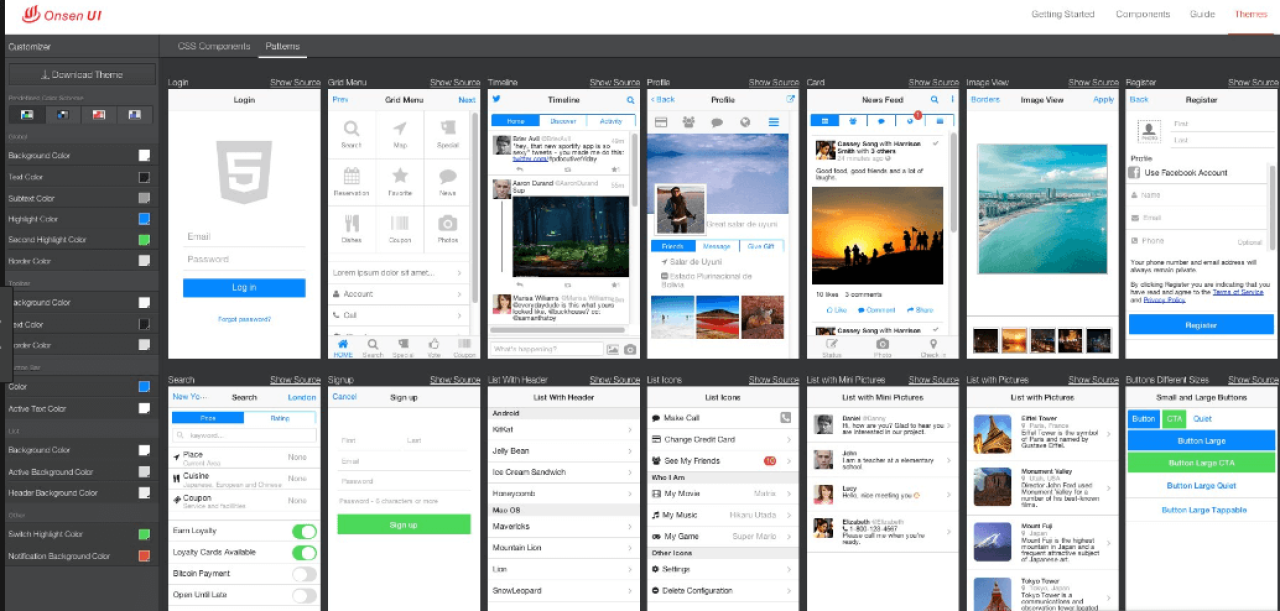
Onsen UI is a large set of rich UI components specifically designed for mobile apps. It is packed with ready-to-implement features following native iOS and Android design standards. It is free to use, 100% open source software. It’s perfect for developing hybrid apps using Cordova or developing mobile web apps.
Onsen UI consists of three layers:
- CSS Components, written in cssnext
- Web Components, written in native JavaScript to support ALL frameworks
- Framework Bindings, created for tighter integration with popular frameworks such as Vue.js, AngularJS 1, Angular 2+, and React
What does it offer?
- Easy to learn while also a powerful tool to create complex mobile apps.
- All animations in Onsen UI have been tuned and optimized to perform well on a wide range of devices.
- UI components specially designed for mobile apps. Onsen UI provides tabs, side menu, stack navigation, and tons of other components such as lists and forms. They all have iOS and Android material design support, with automatic styling that will change the appearance of the app based on the platform.
- Powerful CLI and desktop app simplify complicated tasks. Plus, these tools are integrated with a debugger app with the live-reload feature, remote-build, and many other Cloud features.
- Experience streamlined development with zero-time setup, with the technologies you already know and love: JavaScript, HTML, and CSS.
PhoneGap
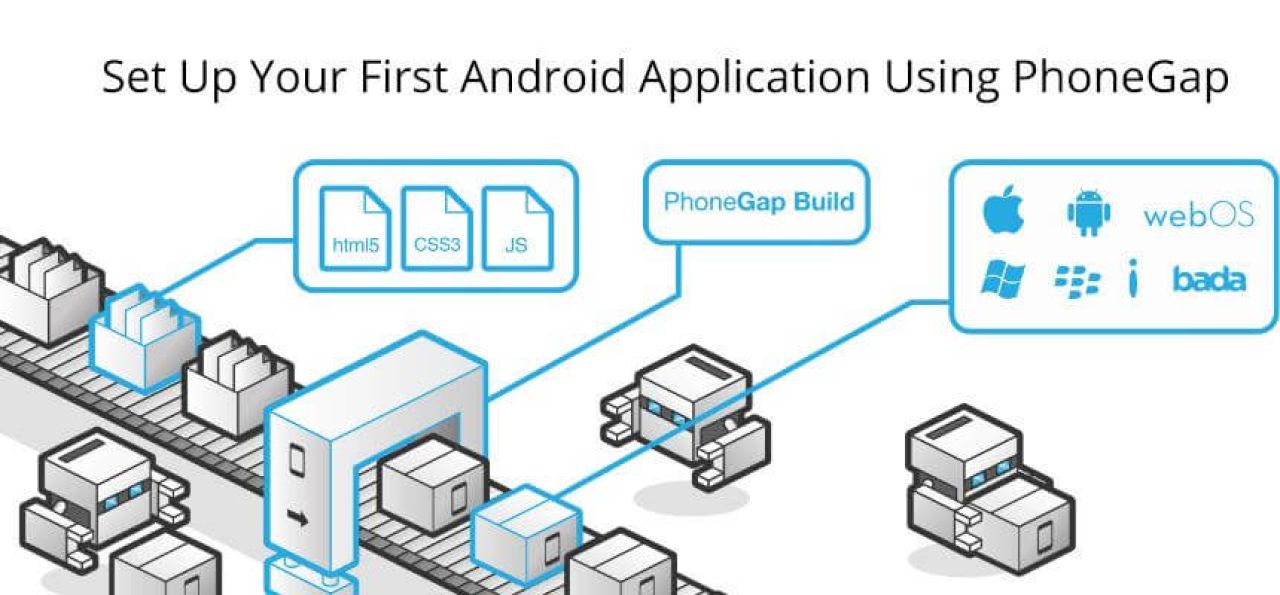
PhoneGap is a mobile application development framework based upon the open source Apache Cordova project. It allows you to write an app once with HTML, CSS, and JavaScript, and then deploys it to a wide range of mobile devices without losing the features of a native app. It is essentially an intuitive desktop app used to create apps and serve those apps to connected mobile devices. The app makes it possible to instantly see changes on your connected mobile device. Other things that make PhoneGap so recommendable are its large plugin library, third-party tools, and thriving community.
What does it offer?
- Access to the PhoneGap toolset, so you can get to mobile faster.
- Create new PhoneGap apps without using the command line.
- Connect your devices to your development machine, then see the changes you make instantly.
- Get app-store ready apps without the headache of maintaining native SDKs.
- Get access to the robust library of plugins to fully extend the capabilities of your hybrid mobile applications.
- Find additional tools created by our amazing community to help you test, debug, and manage your apps.
- Connect and collaborate with our community of thousands, from beginners to experts, all working with PhoneGap.
Picasso
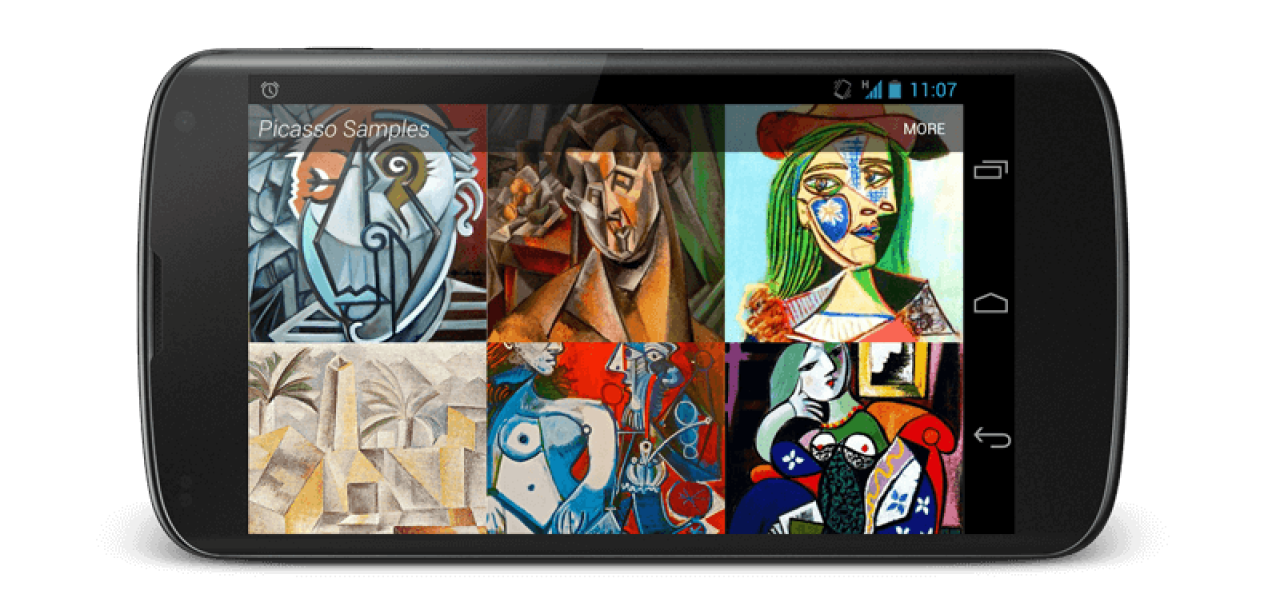
Picasso is an open source media management framework for Android. It wraps media decoding, memory and disk caching, and resource pooling into a simple and easy to use interface. Picasso supports fetching, decoding, and displaying images. It includes a flexible API that allows developers to plug into almost any network stack.
Picasso’s primary focus is on making scrolling any kind of a list of images as smooth and fast as possible. But it is also effective for almost any case where you need to fetch, resize, and display a remote image.
What does it offer?
- It simplifies the process of loading images from external URLs and displays on your application. For example, downloading an image from the server is one of the most common tasks in any application, and it needs a larger amount of code to achieve this via Android networking API’s. By using Picasso, you can achieve this with few lines of code.
- It is not always about downloading an image from the remote location. You also have to think of implementing image caching logic to provide a seamless user experience. Picasso provides automatic image caching.
- Image transformation is a costly affair. If your application needs to deal with such runtime image transformation, you must be watchful about OutOfMemoryException. Picasso deals with it, so you don’t have to do it yourself.
React Native
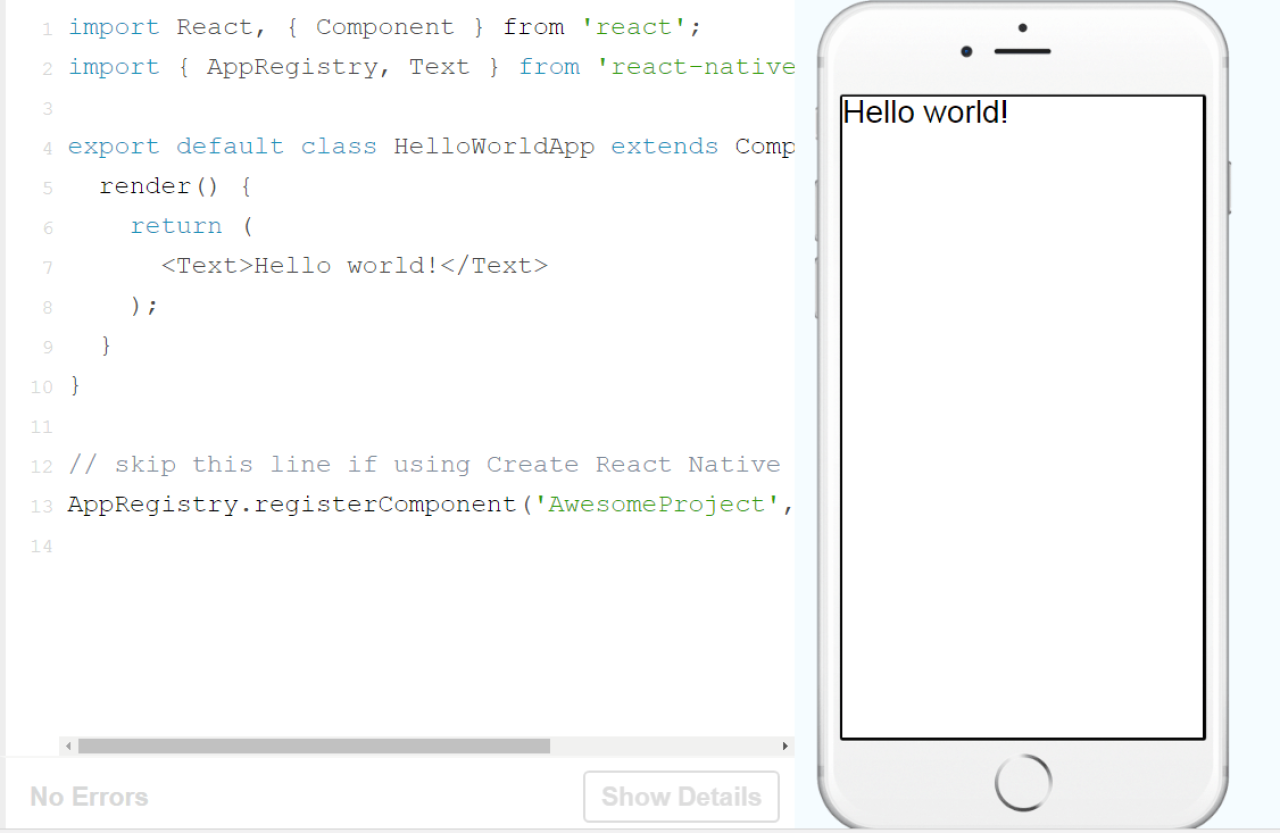
React Native is an open source framework. It is a spin-off of Facebook’s React JavaScript framework, which famously replaced the earlier HTML5 foundation. This high-end, iOS-focused program is more of a native app package than a cross-platform framework. But with its new Android support, it loosely fits our requirements, as you can essentially write once in JavaScript and port to both platforms.
What does it offer?
- React Native lets you build mobile apps using only JavaScript.
- You can build a real mobile app that’s indistinguishable from an app built using Objective-C or Java. React Native uses the same fundamental UI building blocks as regular iOS and Android apps. You put those building blocks together using JavaScript and React.
- React Native lets you build your app faster. Instead of recompiling, you can reload your app instantly. With Hot Reloading, you can even run new code while retaining your application state.
- React Native combines with components written in Objective-C, Java, or Swift. It’s simple to drop down to native code if you need to optimize a few aspects of your application.
ReactiveX
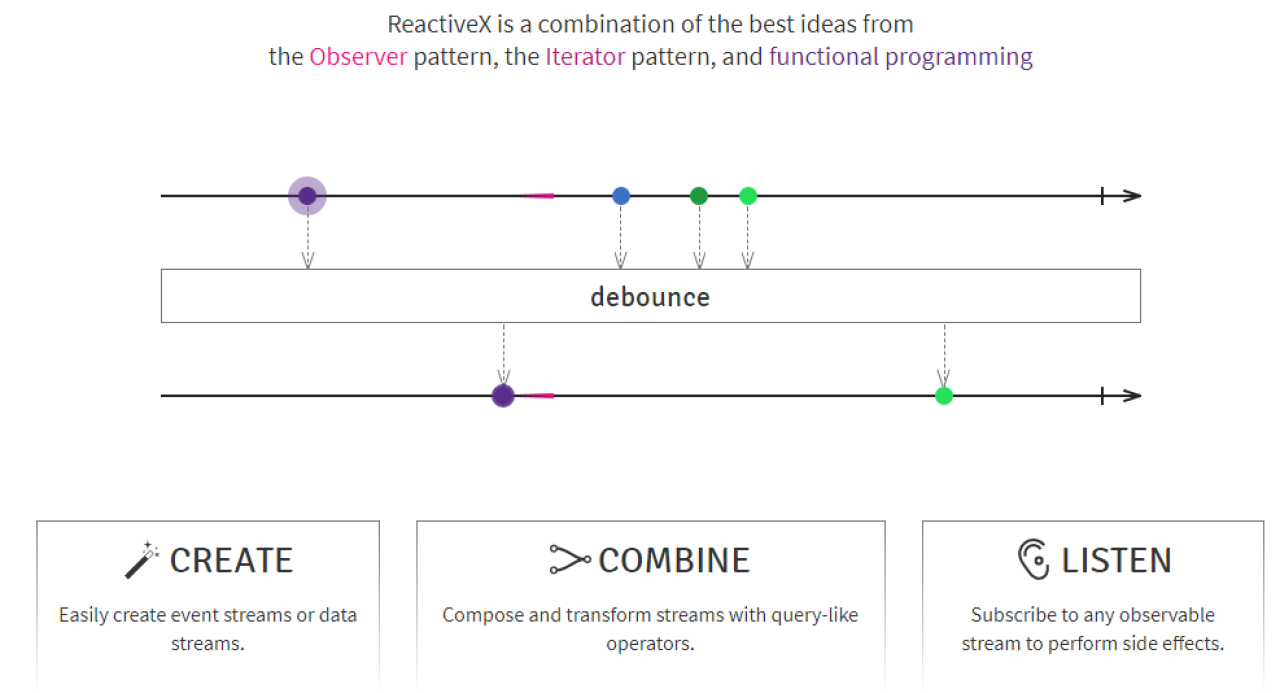
ReactiveX allows you to solve problems in a declarative style that is inherent to functional programming. It has Observer and iterator patterns that help build good software with front-end and back-end parts. This is perfect for Android, which is an event-driven and user-focused platform.
What does it offer?
- Avoid intricate stateful programs, using clean input/output functions over observable streams.
- ReactiveX’s operators often reduce what was once an elaborate challenge into a few lines of code.
- Traditional try/catch is powerless for errors in asynchronous computations, but ReactiveX is equipped with proper mechanisms for handling errors.
- Observables and Schedulers in ReactiveX allow the programmer to abstract away low-level threading, synchronization, and concurrency issues.
Realm
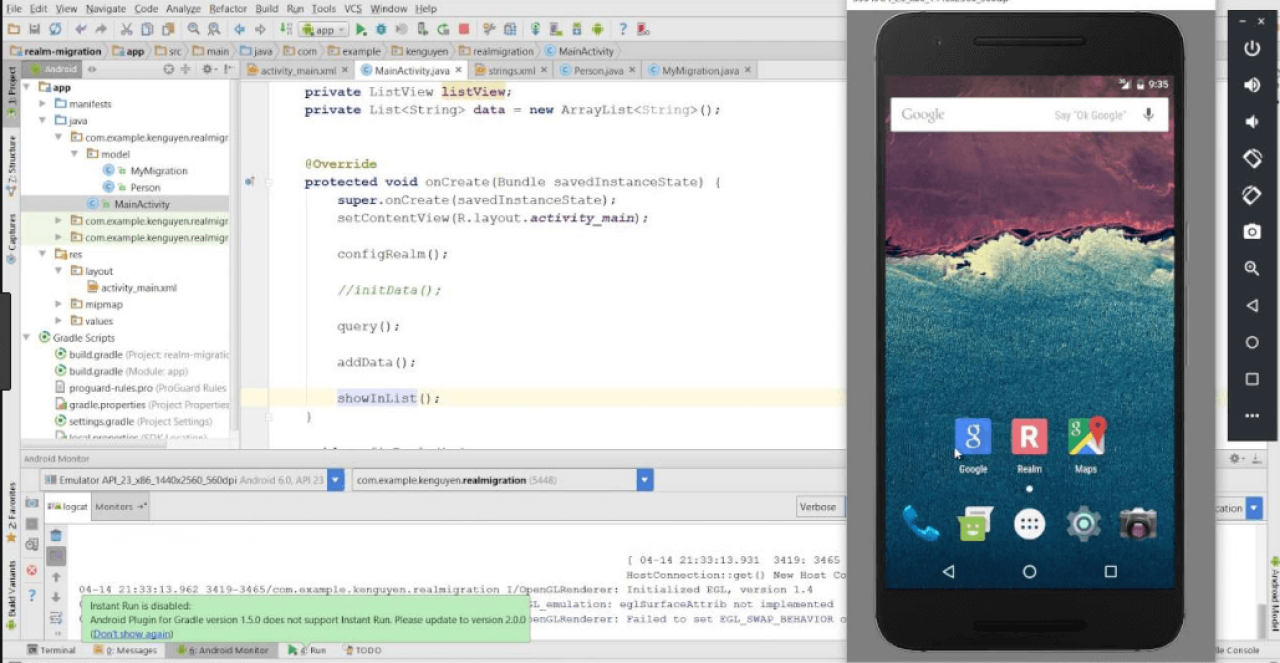
Realm is a mobile database and a replacement for SQLite. Although it is an OO database, it has some differences with other databases. Realm is not using SQLite as its engine. Instead, it has its own C++ core and aims to provide a mobile-first alternative to SQLite. Realm stores data in a universal, table-based format by a C++ core. This is what allows Realm to allow data access from multiple languages as well as a range of ad-hoc queries.
What does it offer?
- Faster than SQLite (up to 10x speed up over raw SQLite for normal operations).
- Easy to use.
- Object conversion handled for you.
- Convenient for creating and storing data on the fly.
- Responsive team.
Retrofit
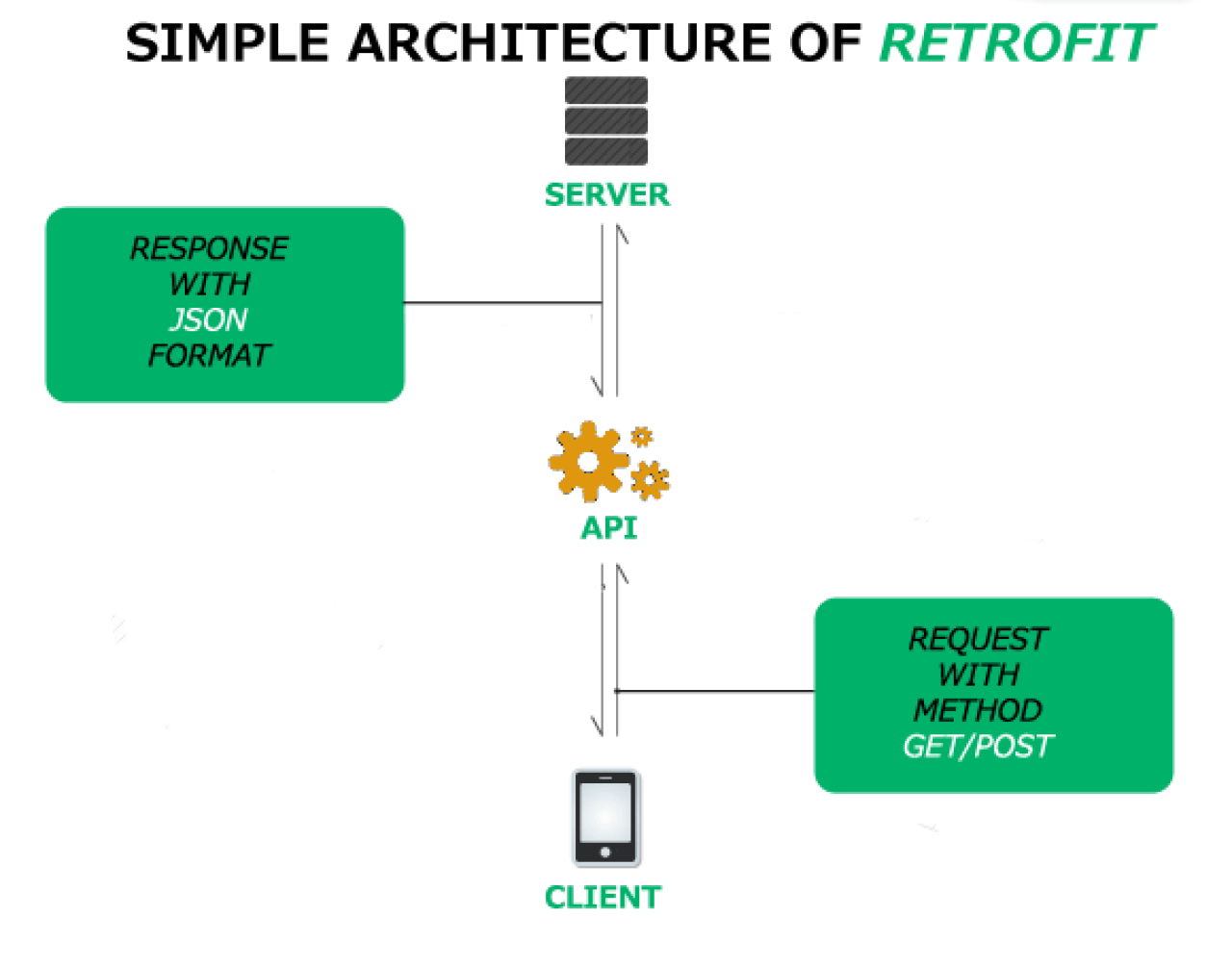
Retrofit is a client-server framework for exchanging data between an app and a backend server. Retrofit is definitely the alternative to Google’s Volley library in terms of ease of use, performance, extensibility and other things. It is a type-safe REST client for Android built by Square. Using this tool, Android developers can make all network stuff much easier.
What does it offer?
- Retrofit turns your HTTP API into a Java interface.
- Retrofit is a type-safe REST client for Android built by Square. The library provides a powerful framework for authenticating and interacting with APIs and sending network requests to OkHttp.
- This library makes downloading JSON or XML data from a web API fairly straightforward. Once the data are downloaded, it is parsed into a Plain Old Java Object (POJO), which must be defined for each “resource” in the response.
Spring for Android
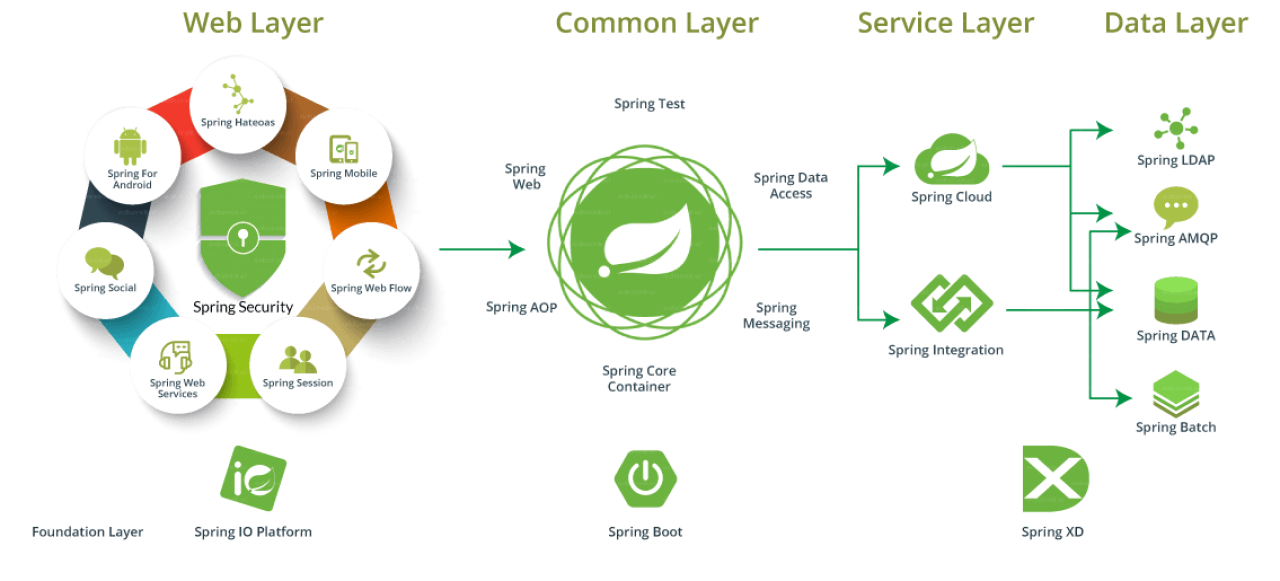
Spring for Android is a framework designed to provide components of the Spring family of projects for use in Android apps. Like all Spring projects, the real power of Spring for Android is in how easily it can be extended.
What does it offer?
- A Rest Client for Android
- Auth support for accessing secure APIs
Stripe

Stripe is a framework for running an internet business. Stripe builds the most powerful and flexible tools for internet commerce. Whether you’re creating a subscription service, an on-demand marketplace, an e-commerce store, or a crowdfunding platform, Stripe’s meticulously-designed APIs and unmatched functionality help you create the best possible product for your users.
What does it offer?
- Easier to integrate and offers greater flexibility for recurring billings.
- Can accept transactions from any country, but the availability of its services does depend on the country in which your business is based.
- Stripe has a settlement period of 7 days.
Twitter SDK
Twitter SDK is a collection of individual feature modules called Kits. It is designed to make interacting with Twitter seamless and efficient. Twitter Kit provides views for Tweets and live timelines, and a composer that makes sharing from your app simple with a few lines of code.
What does it offer?
- Easy to use, interactive components for displaying Tweets and timelines in your app.
- Display standalone Tweets in native views, pull in collections, lists, profile and search content dynamically.
- Tools for composing Tweets, enabling users to share your content on Twitter.
- Automatic handling of API access for displaying content.
- Components for authorizing users; easily log in using the Twitter accounts already on your phone. Request email addresses to accelerate your user registration flows.
- Full-featured tools for accessing the Twitter REST API.
- Monetize your app using Twitter content and MoPub integration.
Xamarin
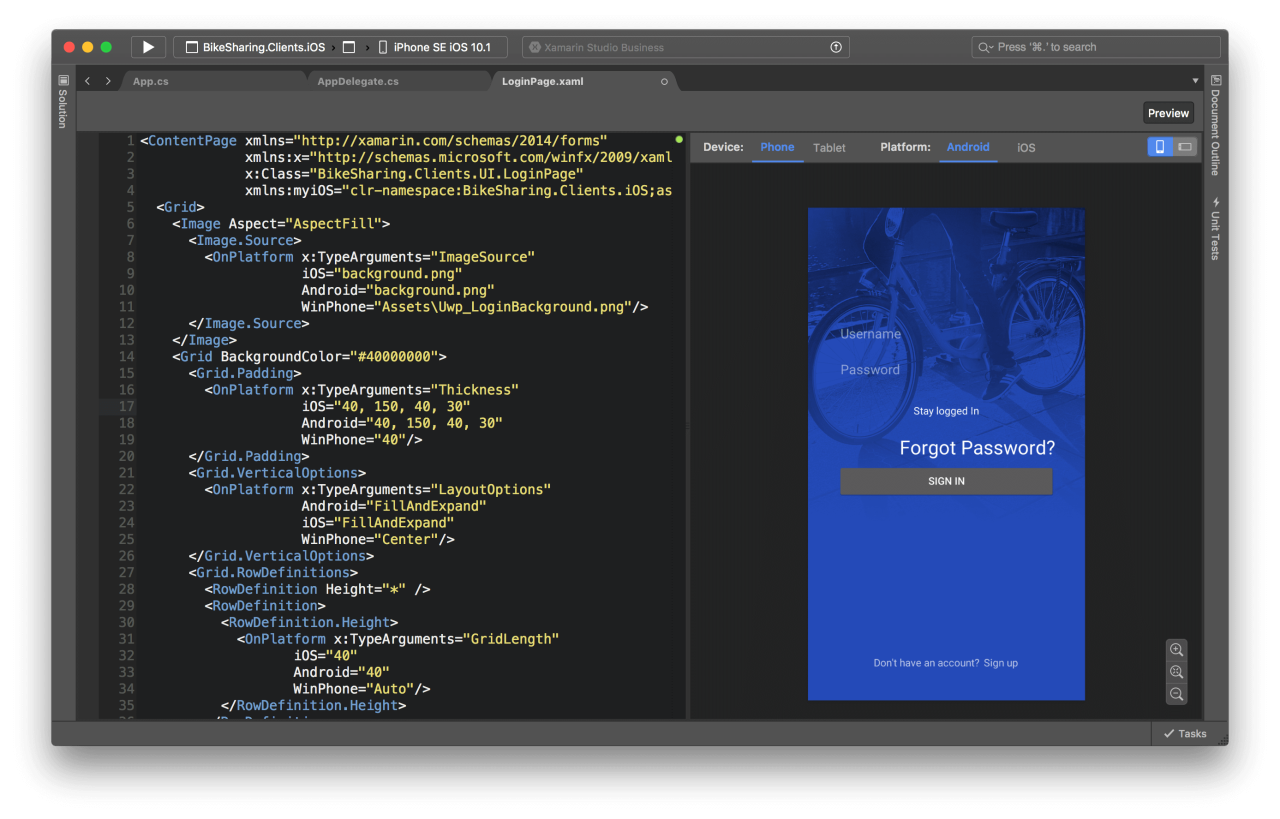
Xamarin has been one of the most advanced and popular tools for cross-platform development for 6 years. This framework connects applications to platform APIs and supports full interaction with complex mobile device sensors.
What does it offer?
- Support for the complete development process. Xamarin allows developers to create every level of the business logic and user interface, as well as provide communication with a server without sacrificing application performance.
- Platform-independent API. The Xamarin Forms API provides optimal conditions for the creation of colorful user interfaces, regardless of the intended platform.
- Strong corporate support. Xamarin includes its own IDE, Xamarin Studio, and a set of tools including Hockeyapp, Xamarin Insights and the test cloud, which minimizes the need to use third-party solutions. Moreover, as Xamarin is a Microsoft subsidiary, the number of Microsoft programs and services that are easily integrated into Xamarin rises every day.
Standard Google Frameworks
As Android is powered by Google, the frameworks Google offers to app developers are quite useful.
Google Play Services
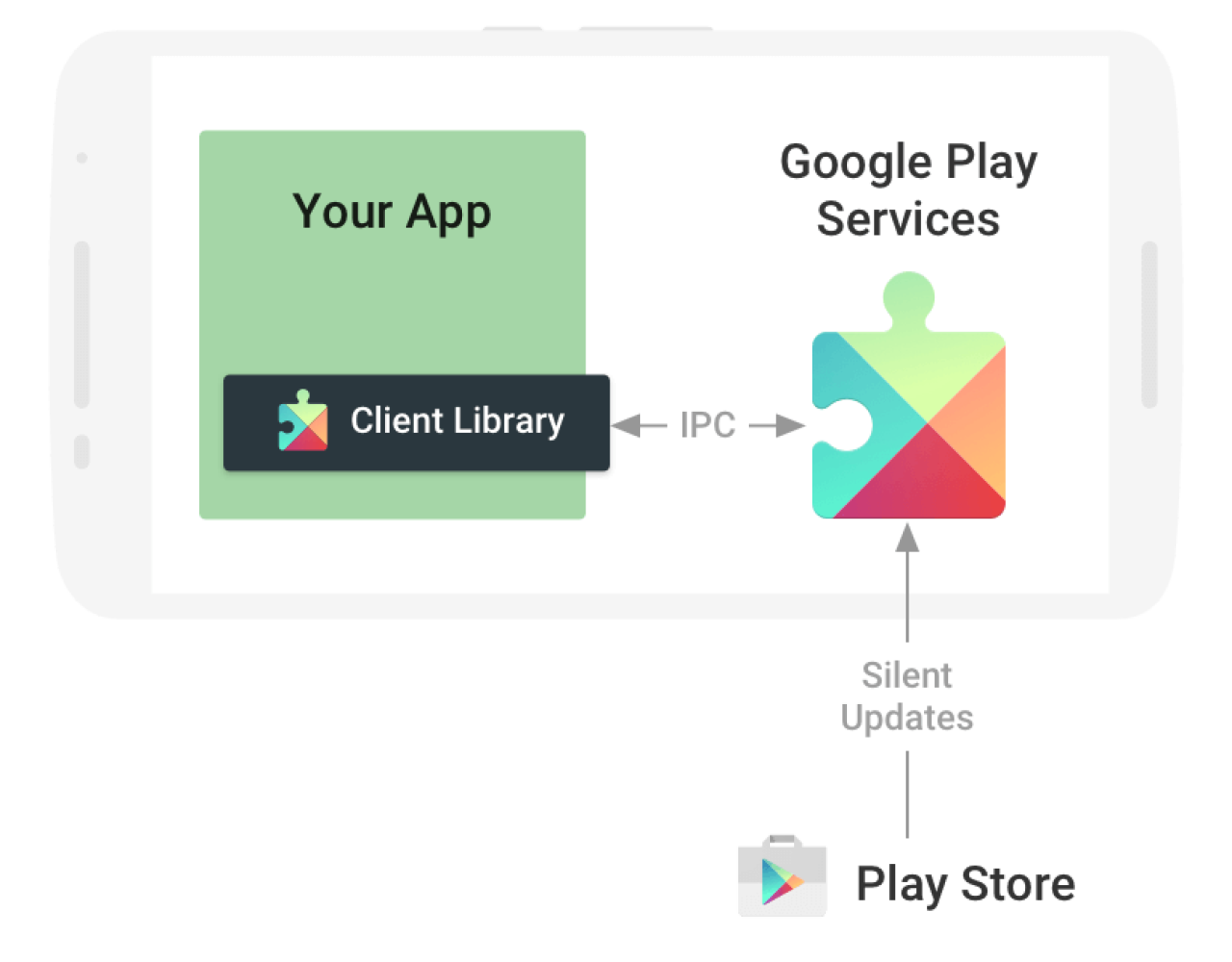
Google Play Services Framework is designed to silently run in the background and support largely in the working of your device. It makes sure that all of the apps on your device are up-to-date by constantly checking on the latest versions available. It is a very important application for all devices that have an Android operating system.
What does it offer?
- The app comes directly from Google to provide supplemental functionality to the software on your device.
- Google Play Services Framework plays a role in app updates, user authentication, location services, privacy settings, etc.
- The framework also helps in speeding up searches, enhancing gaming experience, and improving maps.
- Google Play Services Framework is usually installed on all Android devices by default. If you are missing the app on your device, or if you have the older version of it, do not worry. You can download, install, or update the latest version of it manually with the help of the APK provided below.
Google App Engine
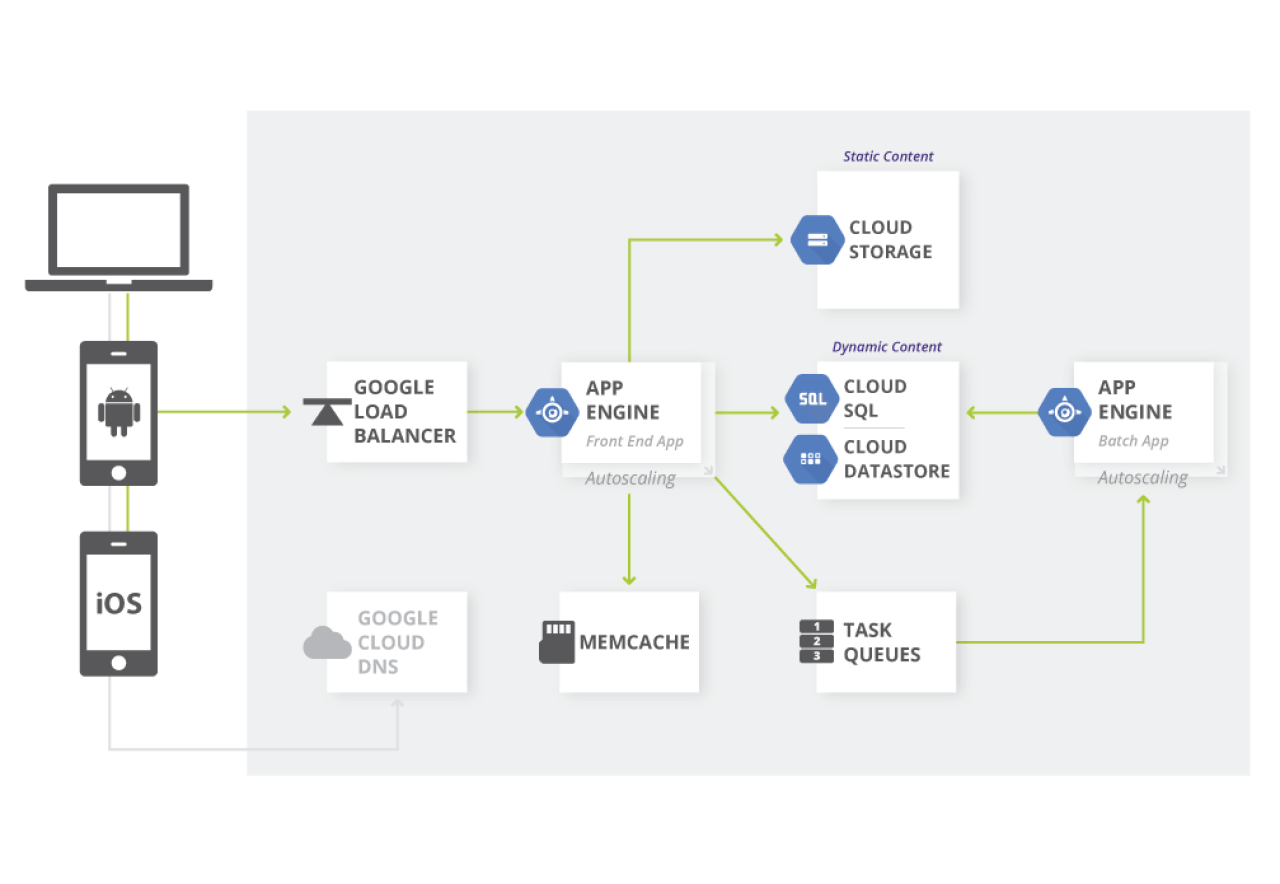
Google App Engine is a web framework and cloud computing platform for developing and hosting web applications in Google-managed data centers. Applications are sandboxed and run across multiple servers. App Engine offers automatic scaling for web applications. As the number of requests increases for an application, the App Engine allocates more resources for the web application to handle the additional demand.
Google App Engine is free up to a certain level of consumed resources. Fees are charged for additional storage, bandwidth, or instance hours required by the application.
What does it offer?
- Persistent storage with queries, sorting, and transactions.
- Automatic scaling and load balancing.
- Asynchronous task queues for performing work outside the scope of a request.
- Scheduled tasks for triggering events at specified times or regular intervals.
- Integration with other Google cloud services and APIs.
Google Analytics
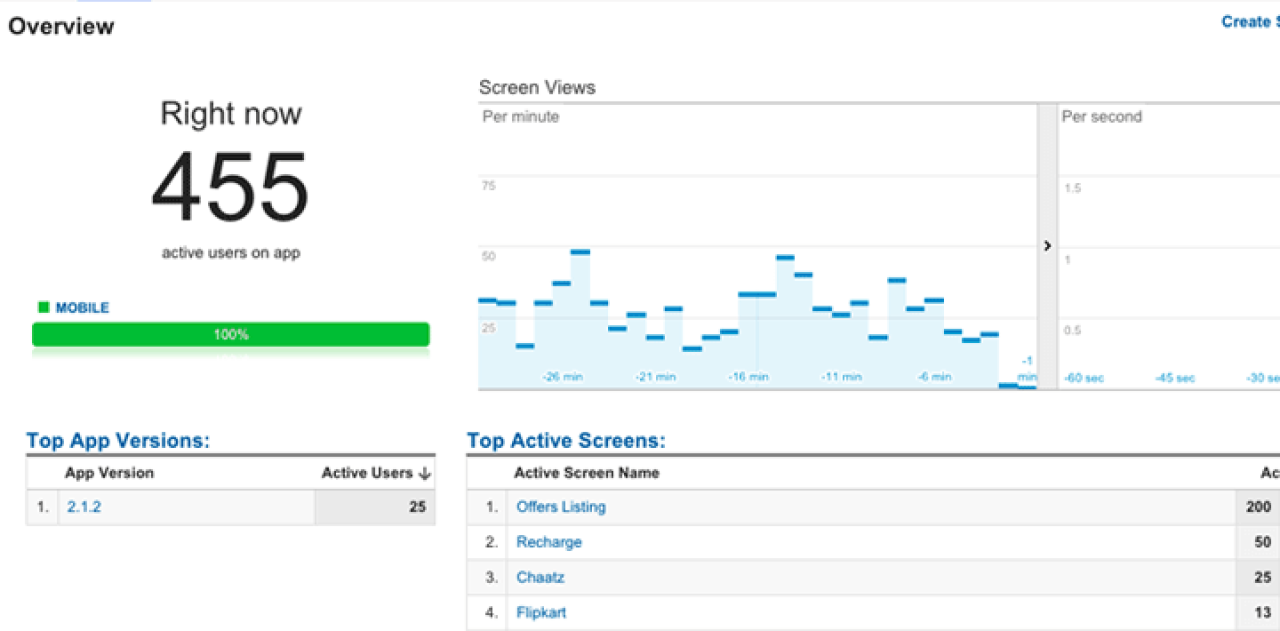
Google Analytics is one of the most popular tools used to track web or mobile traffic. It tracks the user activity, session engagement, and converts the fetched data into more meaningful charts and tables. It helps analyze the information more efficiently and drive various actions to quantify the performance.
Analytics for mobiles collect user activity to your app with an Analytics beacon that sends data to the Analytics servers. Each unique view in your app corresponds to an Analytics screen view. The report aggregates all interaction data within the last 30 minutes.
What does it offer?
- Understand the number of users in your app, their characteristics, and where they come from.
- Measure what actions your users are taking.
- Measure in-app payments and revenue.
- Customize reports specific to your business.
- Visualize user navigation paths.
- Slice and dice your data to understand different user groups’ behavior
- Leverage Google Analytics data in other Google products.
Android Support Library
Android Support Library provides several features that are not built into the standard Android framework and provides backward compatibility for older devices. Include any of these libraries in your app to incorporate that library’s functionality.
What does it offer?
- Backward-compatible versions of framework components. These compatibility libraries allow you to use features and components available on newer versions of the Android platform even when your app is running on an older platform version.
- Additional layout and user interface elements. The support library includes views and layouts that can be useful for your app but are not included in the standard Android framework.
- Support for different device form factors, such as TV or wearables.
- The design support library includes components to support Material Design elements in your app.
- Various other features such as palette support, annotations, percentage-based layout dimensions, and preferences.
TensorFlow
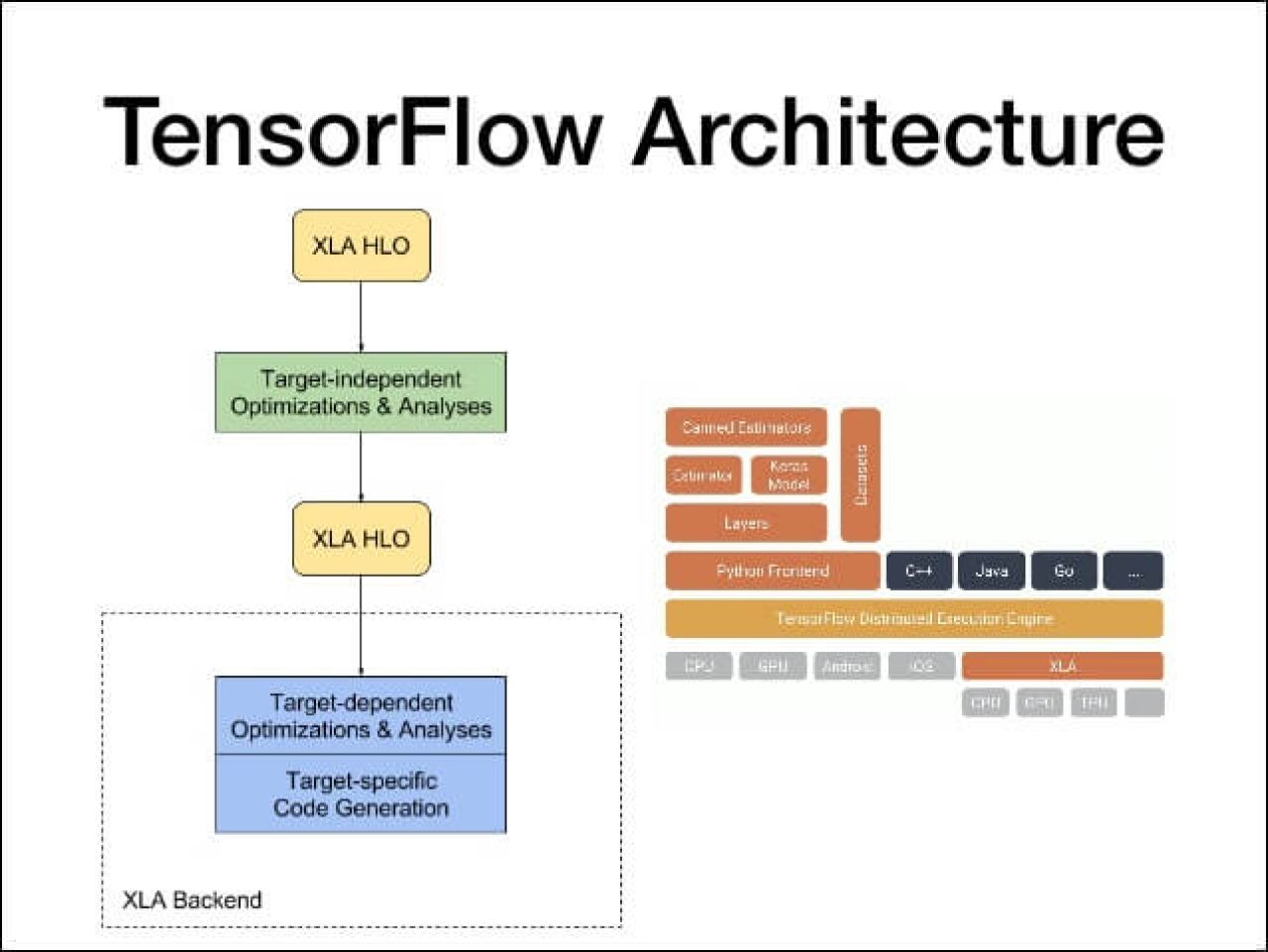
TensorFlow is an open source software library for numerical computation using data flow graphs. TensorFlow was originally a project developed by the Google Brain Team in Google’s Machine Intelligence research organization to conduct machine learning and deep neural network research. But the technology is applicable to a number of other domains as well.
In more technical terms, the deep learning framework is a both a production-grade C++ backend that can run on CPUs, Nvidia GPUs, Android, iOS, and OS X, as well as a Python front-end that interfaces with Numpy, iPython Notebooks, and another Python-based tooling, writes Vincent Vanhoucke, Tech Lead and Manager for the Brain Team on his Google+ profile.
What does it offer?
- The core library is suited to a broad family of machine learning techniques, not “just” deep learning.
- Linear algebra and other internals are prominently exposed.
- In addition to the core machine learning functionality, TensorFlow also includes its own log in system, its own interactive log visualizer, and even its own heavily engineered serving architecture.
- The execution model for TensorFlow differs from Python’s scikit-learn, or most tools in R.
Paid frameworks
Here we look at to a couple of paid frameworks for your Android app. Check it out!
Trigger.io Forge
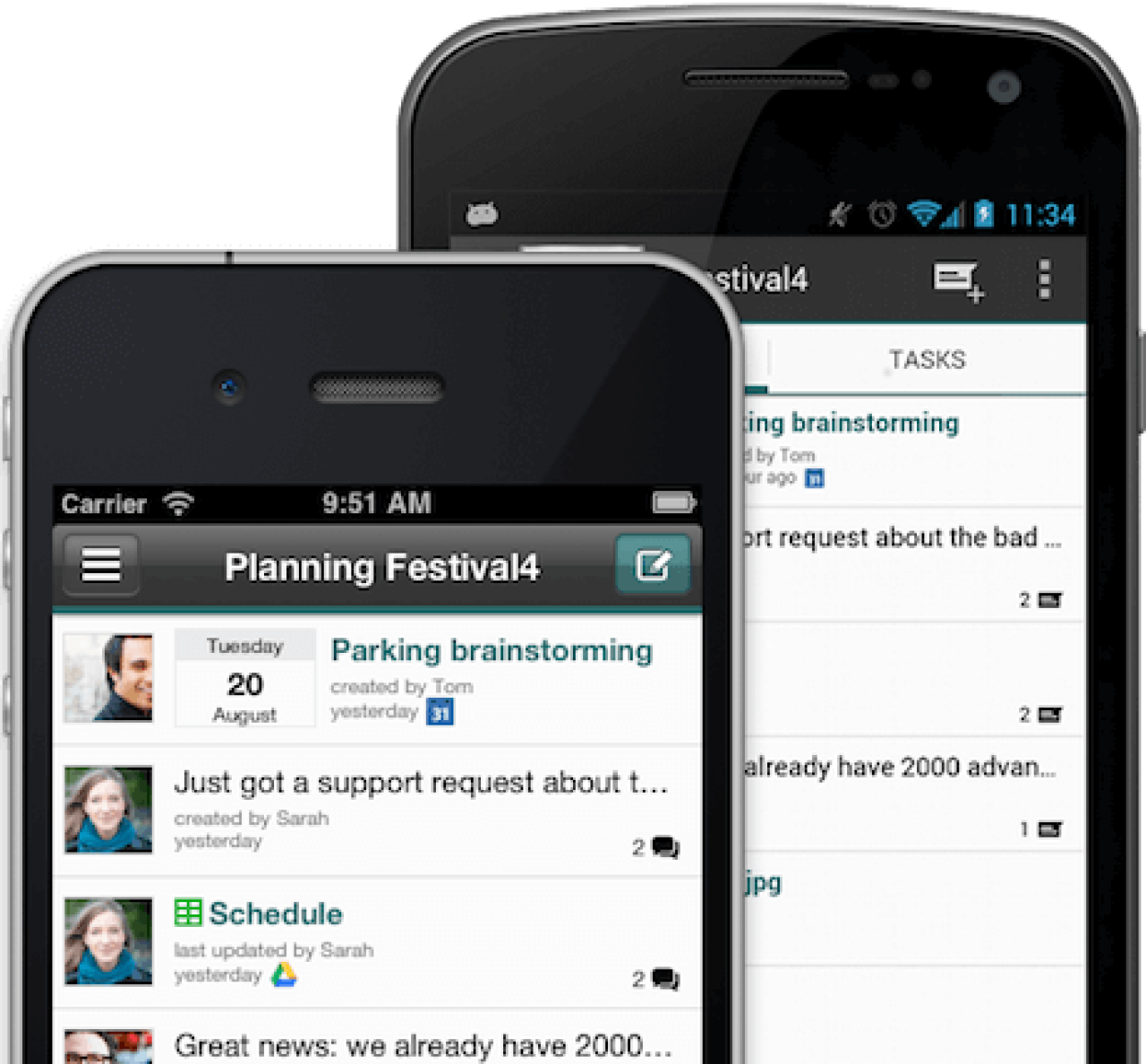
Forge is a framework that enables users to create native apps for multiple platforms from a single HTML5 codebase. It consists of a JavaScript API that exposes device functionality, UI components and a cloud build service to compile your app for each platform that you want to support.
What does it offer?
- Build native apps for iOS and Android using JavaScript
- Native UI, push, analytics, login modules “out-of-the-box”
- Cloud build service, no need to setup Eclipse / Xcode
- Update your app without re-submitting to the App Store
- Open platform, extend with hooks, write native modules
Mixpanel analytics
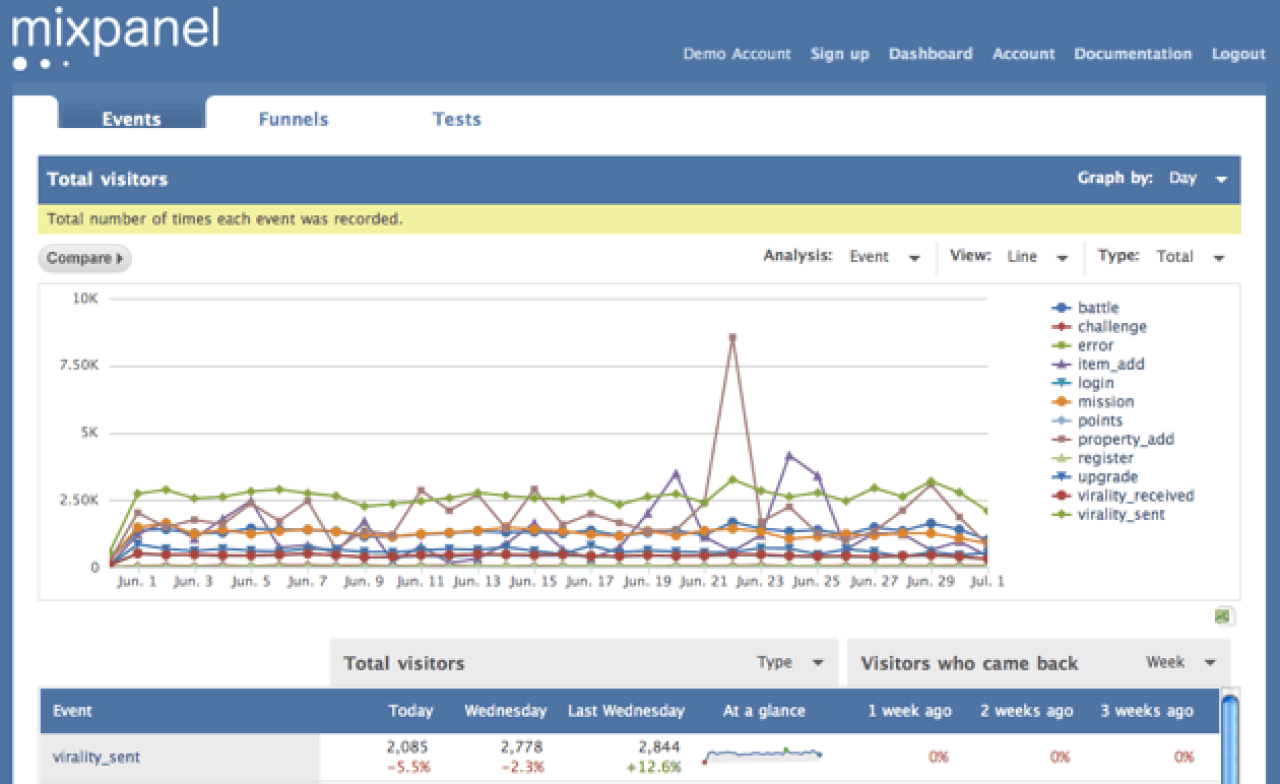
Mixpanel is a business analytics service that tracks user interactions with applications and provides tools for targeted communication with them. Its toolset contains in-app A/B tests and user survey forms. Data collected are used to build custom reports and measure user engagement and retention. Mixpanel works with web applications, in particular, SaaS, but also supports mobile apps.
What does it offer?
- Tracking user actions on your website is even easier with Autotrack. Autotrack automatically tracks links, buttons, and forms—no additional code needed.
- Building a product people love is about measurement, not intuition. To know how people are using your product, you need a tool that can easily measure those insights. Mixpanel helps you ask questions about your users and delivers answers instantly.
- Mixpanel finds hidden gems buried in your data automatically, so you can stop data mining and act on insight quickly.
- Funnel analysis helps you identify where people drop off so you can increase your conversion rates.
Flurry Analytics
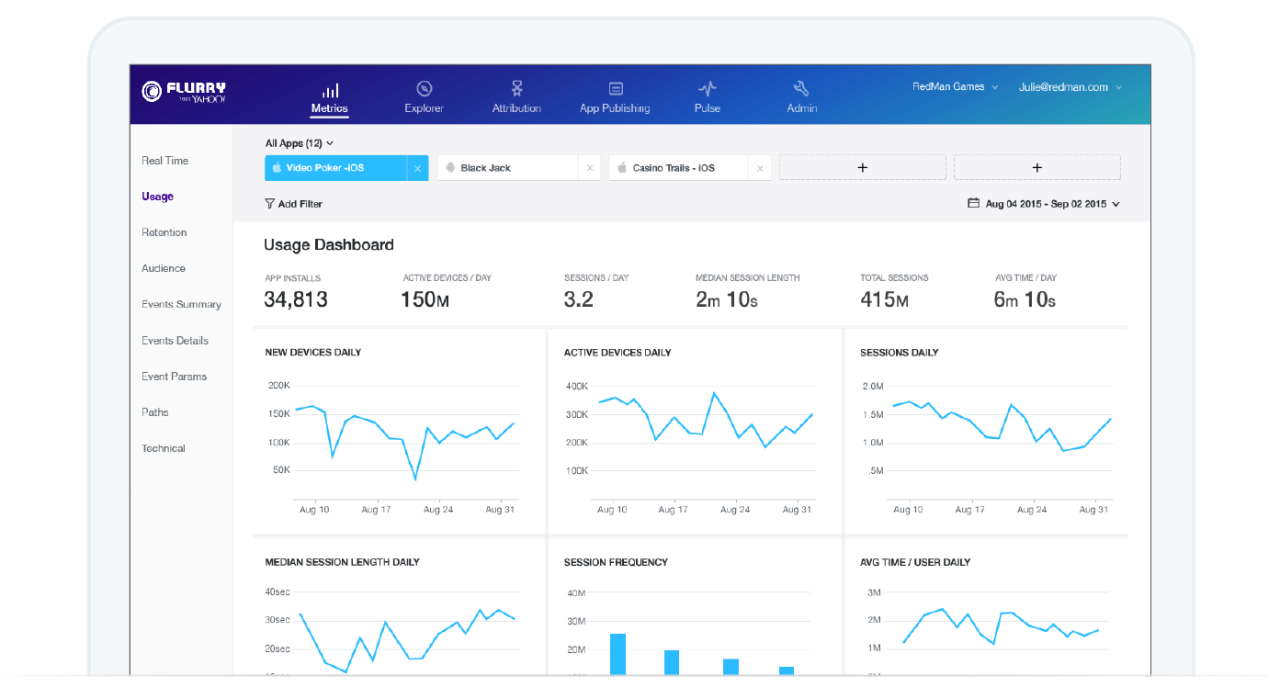
Flurry Analytics, made by Yahoo, provides you with the tools and resources you need to gain a deep level of understanding about in-app user actions. Set up advanced analysis of complex events, with metrics, segments, and funnels to better track your users’ habits and performance.
What does it offer?
- Real-time data on how your app may be impacted by user updates, user acquisitions, or enhancements.
- View all the metrics from a given metric area on a single page.
- Track your In-App Purchase Revenue from transactions that occur within your app to determine the level of revenue.
- Gives you, in real time, information about crashes, exceptions, and errors in your app.
- This allows you to determine the root cause of any issue quickly and keep your app running well.
- Enables you to export data based on standard formats such as CSV and JSON. Then it allows integration into web dashboards, data warehouses, and any other system.
- Select multiple items for display at the same time and quickly move between comparisons.
- Apply filters, like Country, Age, Gender and Language on the fly and view the results instantly.
- Groups, which let you take items like Apps or Events and group them together to quickly move between the contexts that matter for you.
- The frictionless workflow that adapts to how you work, not the other way around
Now go make some money…
So these are the top Android application development frameworks that every mobile app developer should try. If you are finding it difficult to develop an application for the Android platform, you can hire an experienced Android app developer from any experienced mobile app development company.
Whether you need to engage a million Android users or create cross-platform experiences from the ground up, VironIT software development company has the team and experience to develop your vision. Our team has expertise in iOS, Android, and Web application development.
Contact us today for an intuitive and fast app solution for your business or enterprise.

 (4 votes, average: 4.25 out of 5)
(4 votes, average: 4.25 out of 5)

